For many visitors, a cruise is a popular way to see the marvellous Galapagos islands. There are lots of options available, from bigger ships (up to around 100 passengers) to smaller motor yachts. But what if cruising isn’t for you? Mitch is a pathetic sailor and gets incredibly seasick, even on seas that aren’t very rough. We had long wanted to visit the Galapagos but were put off for a long time by the prospect of travelling in boats. Sleeping in a bed that didn’t move was a high priority! So we explored options for a Galapagos land based itinerary.
While it is possible to take a predominantly land based trip to the Galapagos we do recommend some boat excursions as there are many islands to visit and each has different characteristics and a diverse array of wildlife. There are quite a few that are reachable within a couple of hours’ boat journey from the large island of Santa Cruz so it is possible to do a number of day trips, which means you can explore some of the other islands without spending too much time on a boat. It is possible to fly between some of the islands (Baltra, which serves Santa Cruz, San Christobal and Isabela) but flight prices can be expensive, luggage size restrictive and the flight times aren’t always reliable.
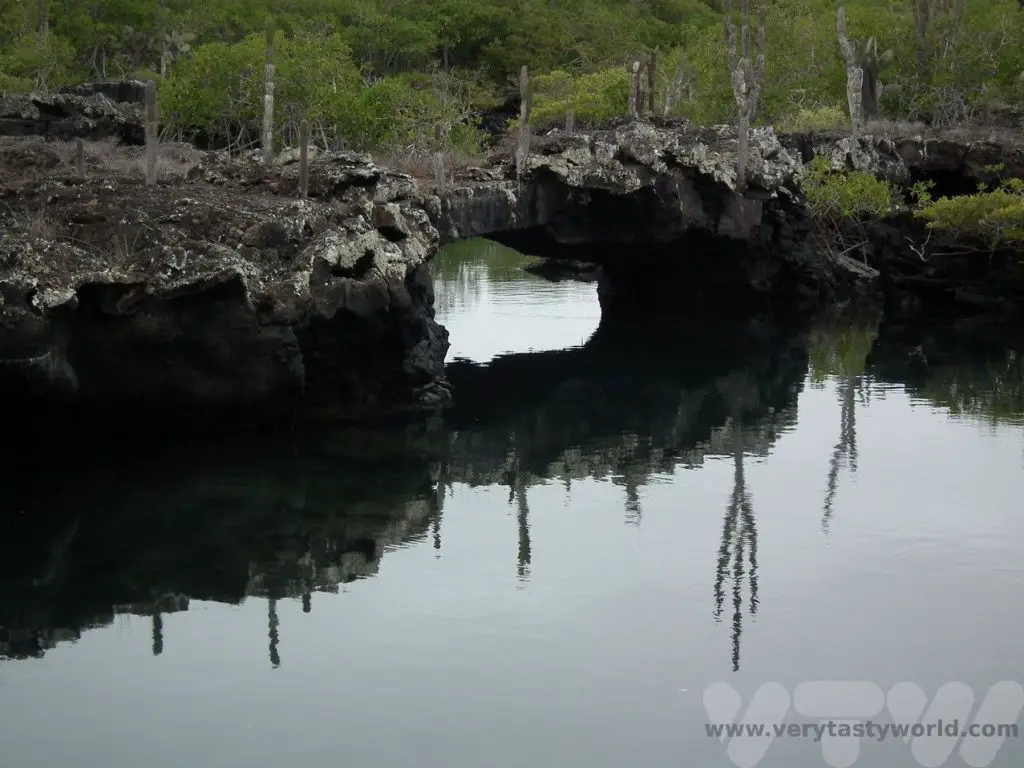
Where Are The Galapagos?
The Galapagos are an archipelago in the Pacific Ocean and a province of Ecuador. Located around 1000km from the west coast of Ecuador, these volcanic islands are located in the Pacific Ring of Fire and formed over several millions of years due to the immense volcanic activity in the area. They are still geologically active, with some 13 active volcanoes.
Naturalist Charles Darwin visited the Galapagos islands in 1835 on the second voyage of the Beagle and his study of the local finches formed the basis of his work The Origin of the Species. He observed that the finches from each island had noticeable variations in the development of their beaks due to the different types of food available and variation in the living conditions. This led to him developing the theory of evolution.
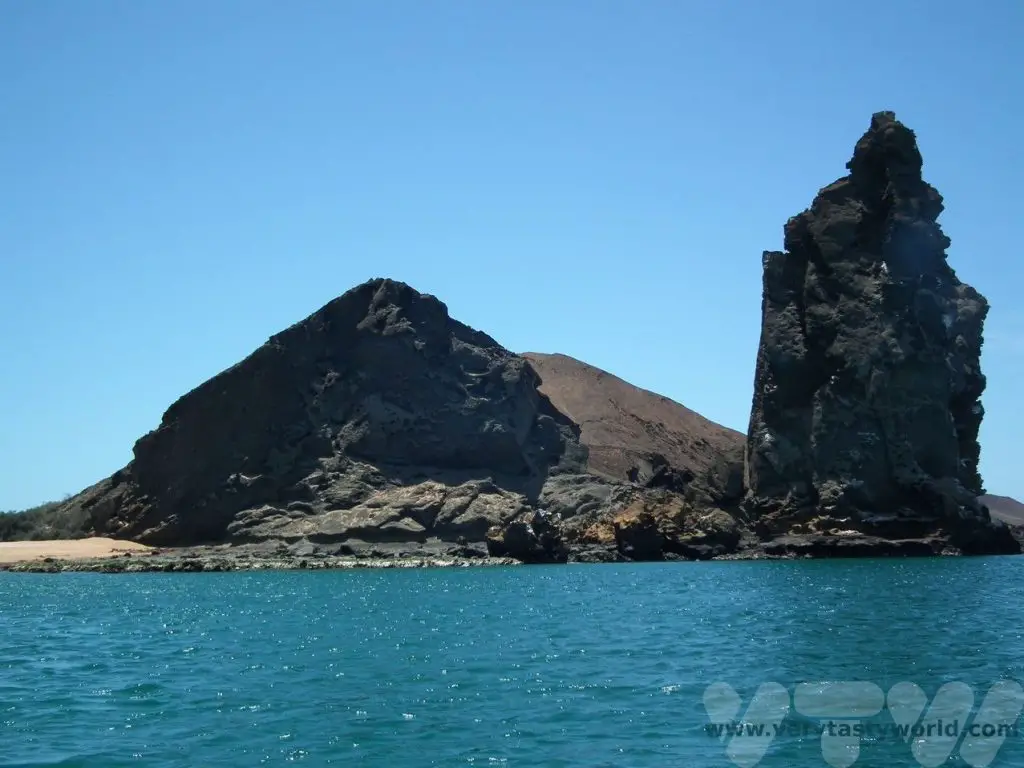
The islands are rightly famous for their unique wildlife. What is magical about visiting the Galapagos is that the animals haven’t learned to fear humans so you can get really close to them. In fact, you really have to look out to make sure you don’t accidentally step on an iguana! The Galapagos were established as a national park in 1959 and the wildlife and ecosystems are fiercely protected. They are a UNESCO world heritage site.
We made our own way to the Galapagos via Ecuador’s capital, Quito, but found a local company that could arrange excursions for us. We recommend booking hotels and day trips in advance of travel to be sure of getting a place on the tours.
Arrival
Most people fly into the Galapagos from mainland Ecuador, either Quito or Guayaquil. There are airports on Baltra and San Christobal. Before leaving the domestic terminal your luggage will be checked for restricted items by Tourist Control and Certification. This will cost $20 US.
The aim of this check is to protect the wildlife of the Galapagos. Therefore it is important to ensure that you aren’t carrying any animal products, plants or seeds into the islands. It’s inadvisable to bring food. Pre-wrapped snacks will probably be okay but don’t bring things like sandwiches with meat/cheese products.
We flew into Baltra airport. On arrival you will go through immigration and pay the $100 entrance fee.
Luggage usually isn’t collected straight away – when we arrived the whole plane’s worth of luggage was placed inside the terminal building and no one was allowed to pick up their bags until a sniffer dog had had a really good snuffle to smell for restricted items. After the security guards give the okay, it then turns into a bit of a scrum as everyone dives for their possessions. It’s definitely worth waiting for the chaos to subside.
Then everyone boards a coach which transports you across the stark island of Baltra to a ferry for a very short journey across the Itacaba channel to Santa Cruz. The crossing takes around 5-10 minutes. Then it’s a 45 minute bus ride to the main town of Puerto Ayora. After a quick lunch, we headed directly to the port to catch a boat to Isabela.
Galapagos Land Based Itinerary: A Couple of Days on Isabela
Isabela is the largest island and also the youngest, a mere one million years old. We had arranged a couple of nights there, travelling from Puerto Ayora on Santa Cruz. This was the worst boat journey and, frankly, it was an endurance. The total travel time is a couple of hours but it was the most bumpy we experienced. When the crew handed out sick bags to all the passengers we knew the trip was going to be rough. And indeed it was. Mitch became reacquainted with her lunch as we bounced across the relentless waves.
If you are prone to seasickness we recommend sitting at the back of the boat, outside where you can see the horizon, and where it is more stable and less susceptible to bouncing. Sit on the right-hand side on the way out and the left-hand side on the way back if you can. That way you’ll avoid getting wet – the waves are quite relentless and the spray regularly sloshes over the side of the boat. It does depend on where other passengers are sitting though – seats aren’t guaranteed, so you might want to arrive at the dock early and get to the front of the queue.
It was such a rough voyage that neither of us were having a fun time at all. (A couple of days later we bumped into some people who had been on that boat. They mentioned that it was good to see us enjoying a hearty meal and looking much happier!)
However, on arriving at Isabela, the seasickness vanished as we stepped onto the landing platform, carefully avoiding a couple of iguanas, before spotting some sea lions snoozing on a seashore bench.
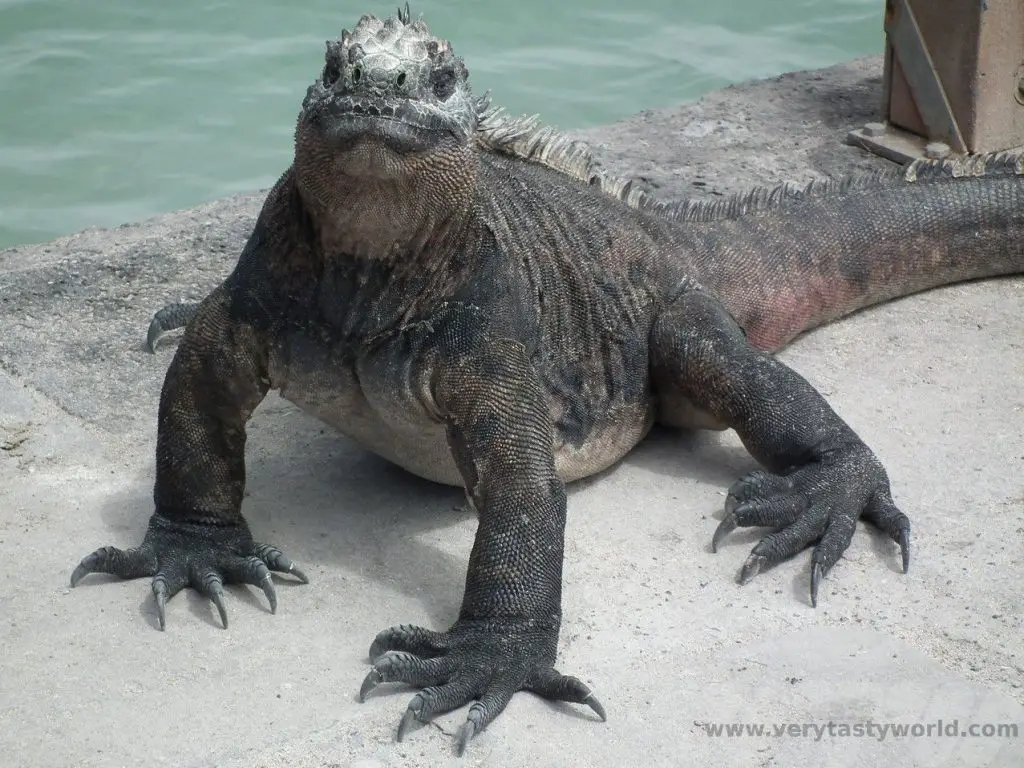
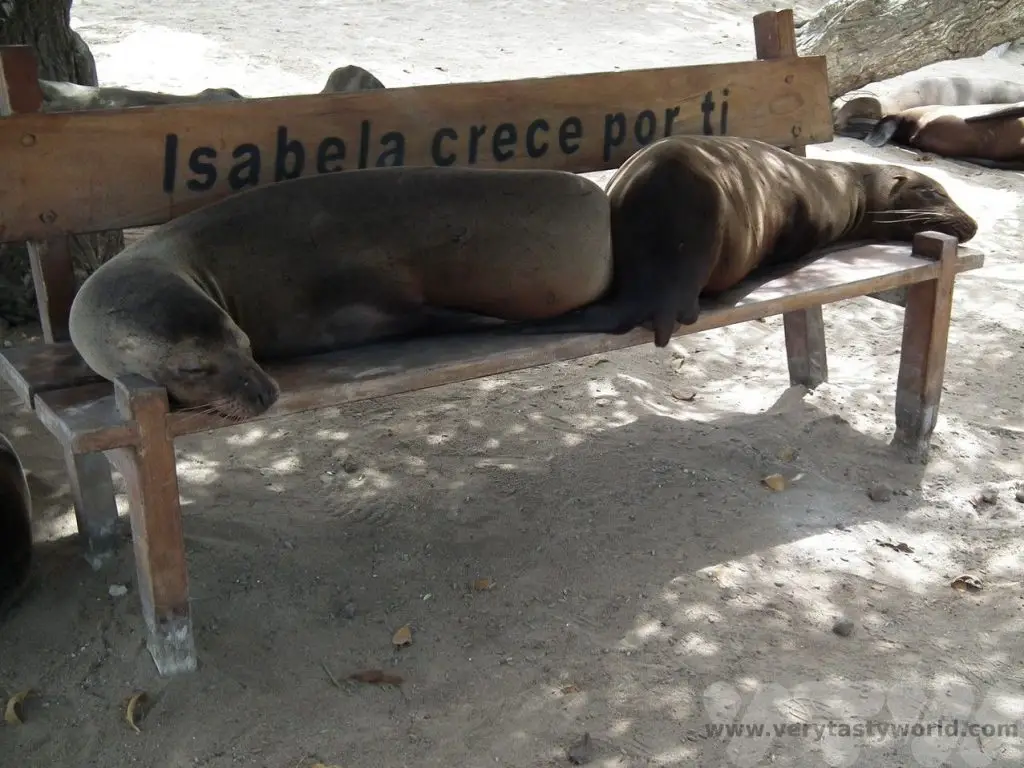
Day 1 Isabela
A full day trip to Los Tuneles is a perfect introduction to the island. This involved a short boat ride, in inshore waters, to the lava formations on the south coast of the island. The area looks mysterious as the lava has formed tunnels and arches along the shoreline. Cacti protrude defiantly from the stark rocky lava.
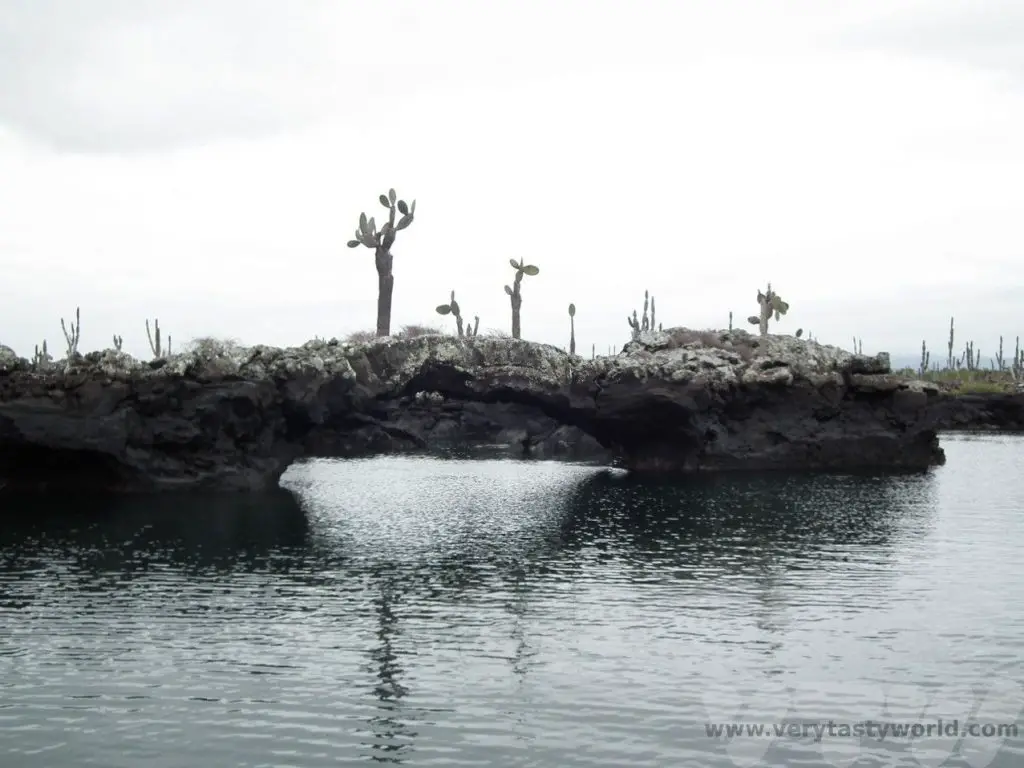
It’s possible to disembark and walk on the lava. We were delighted to encounter the famous blue boobies engaged in their courting ritual. So absorbed by each other, they were totally unperturbed by onlooking visitors.
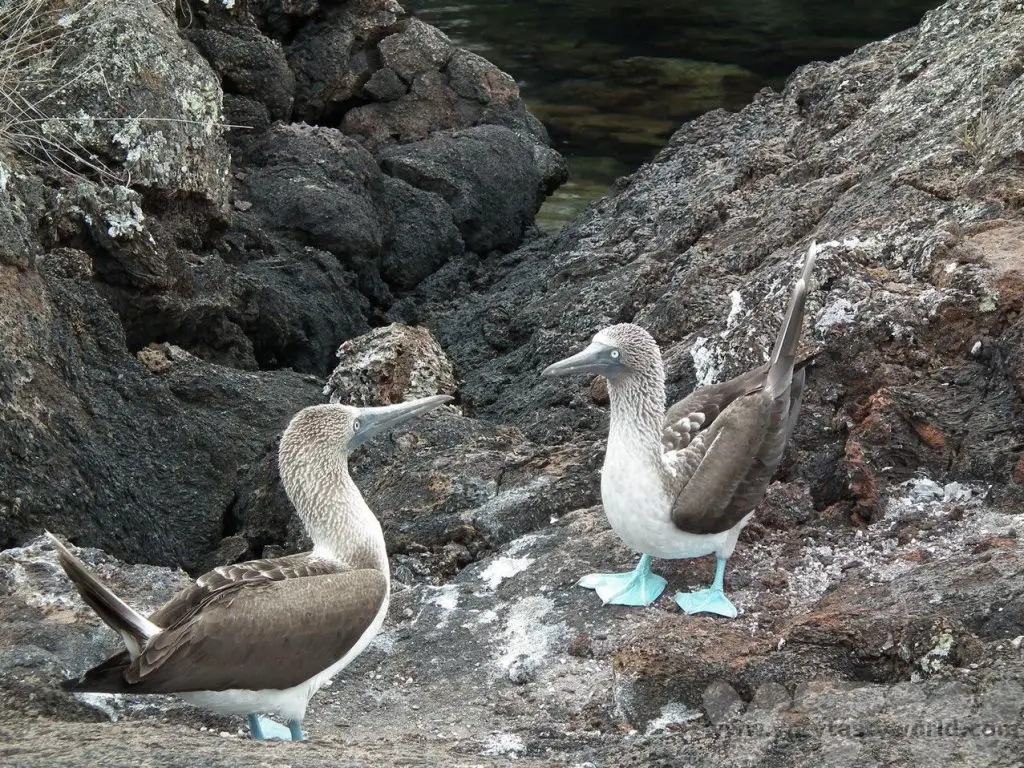
He shows her his blue feet and she admires them.
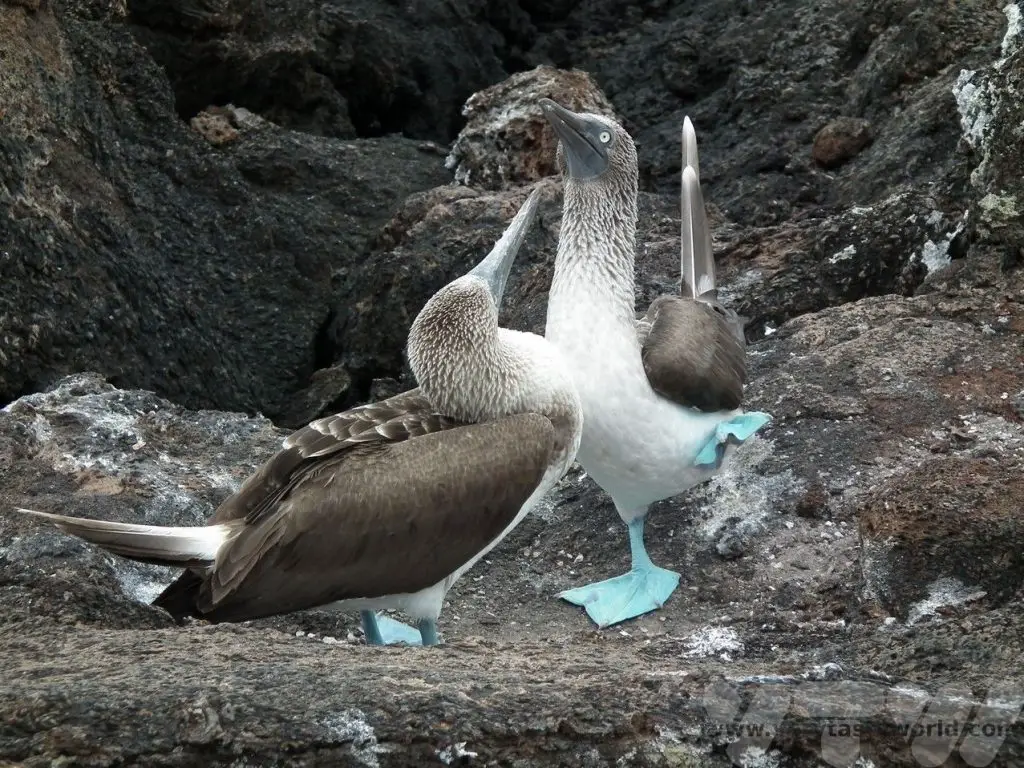
If she is satisfied with the blueness of his feet, she will honk her approval and they will form a pair. They are just adorable.
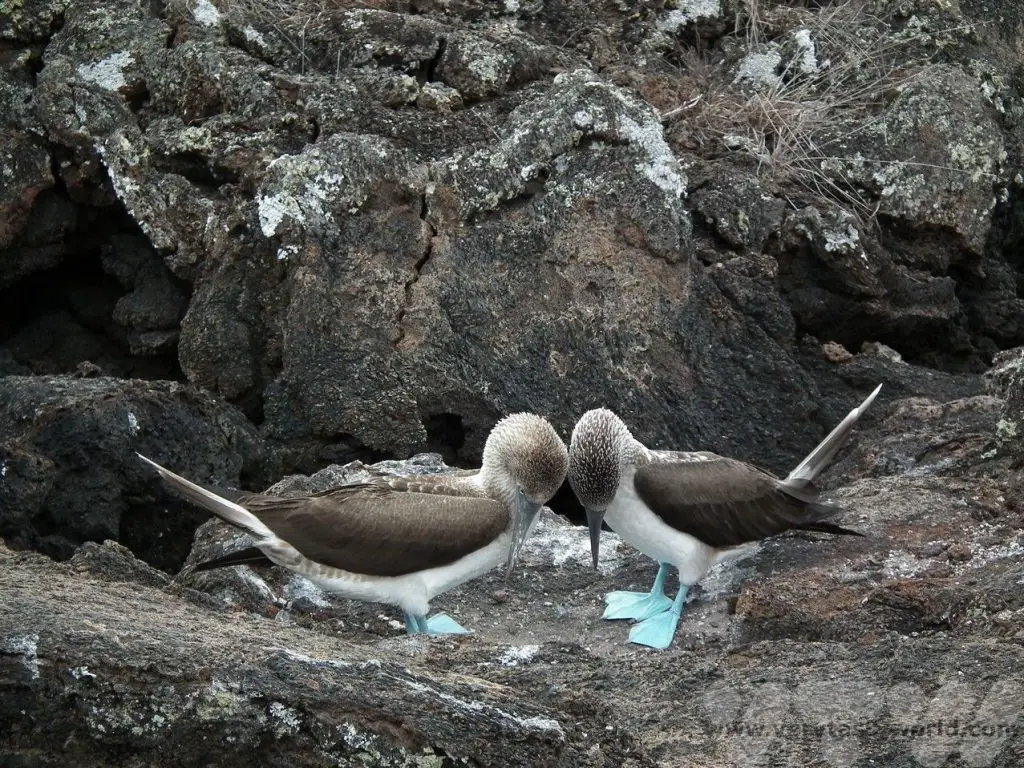
Then it was time to return to the boat, sail along the coastline and then jump into the sea to go snorkelling. Our first encounter with marine life was coming face to face with a turtle.
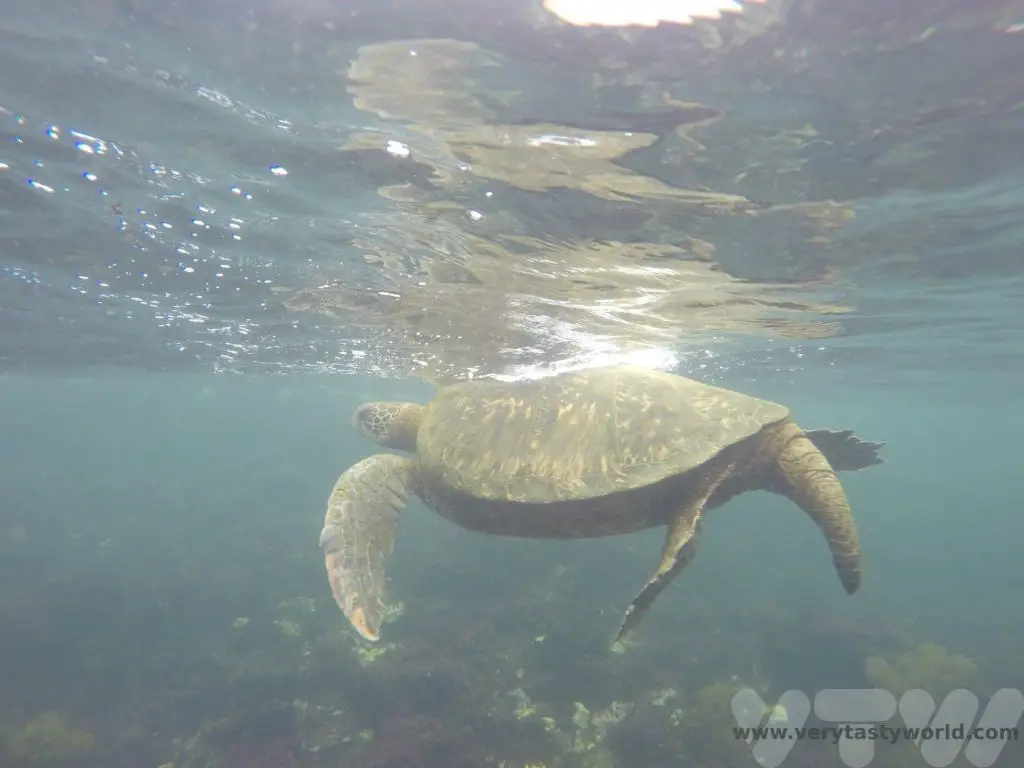
We also saw some sharks snoozing in an underwater cave.
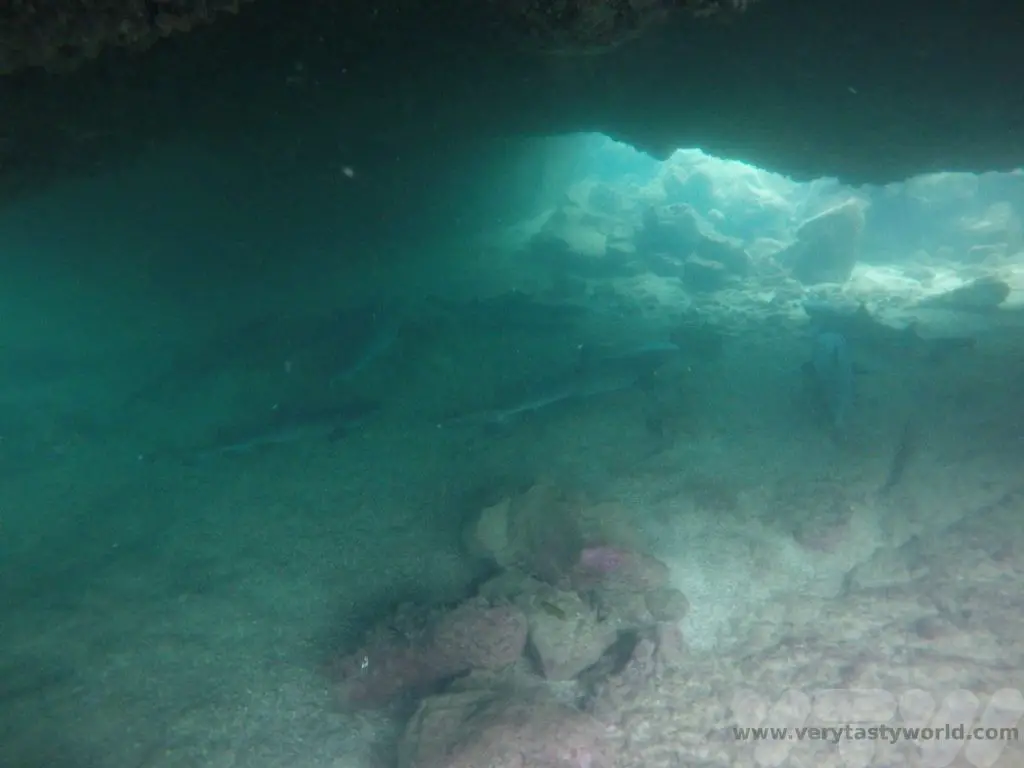
Tip: If you are not confident jumping out of a boat and swimming in open water, the boat company will provide lifejackets which you can wear while snorkelling to give you buoyancy. They are really effective and mean that even those who aren’t strong swimmers can still enjoy wildlife encounters in the water.
You might want to hire a wetsuit for the snorkelling. We hired one on the first day but found the water to be really warm so just wore our swimsuits for all the other water-based activities.
Day 2 Isabela
The day started with a quick trip to see the flamingos at the Puerto Villamil salt lagoons. These reminded us of the Three Graces.
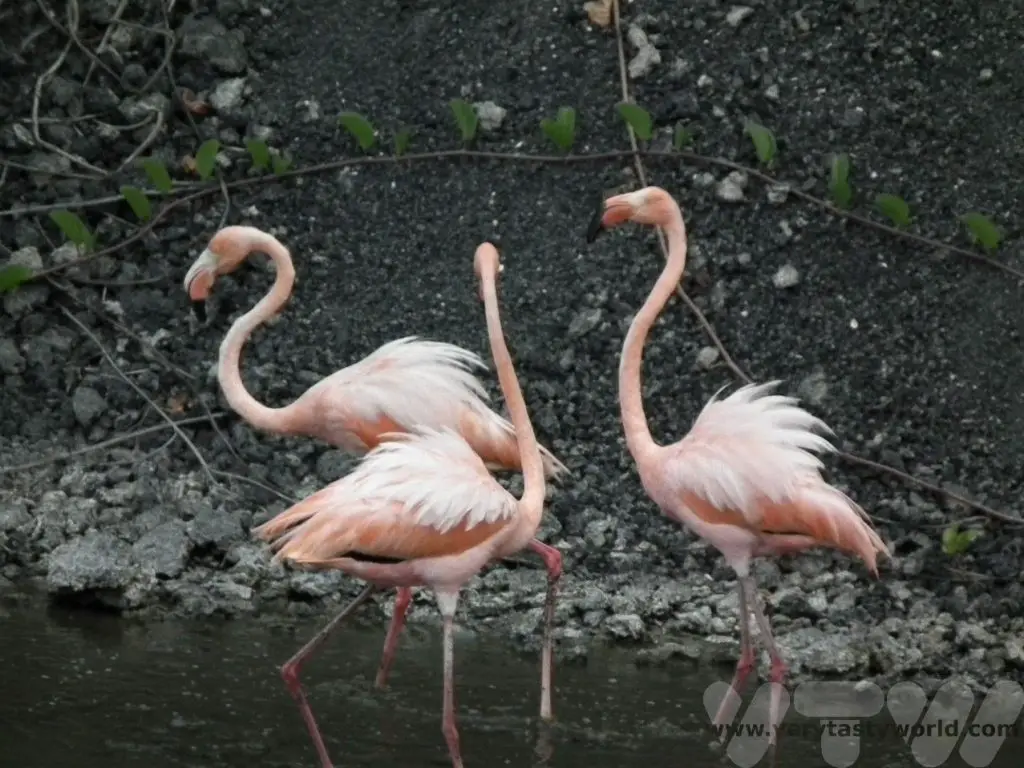
Then it was onto Las Tintoreras, an islet located on the eastern side of the island, which was a very short boat ride across the bay. There is a path to follow around the island.
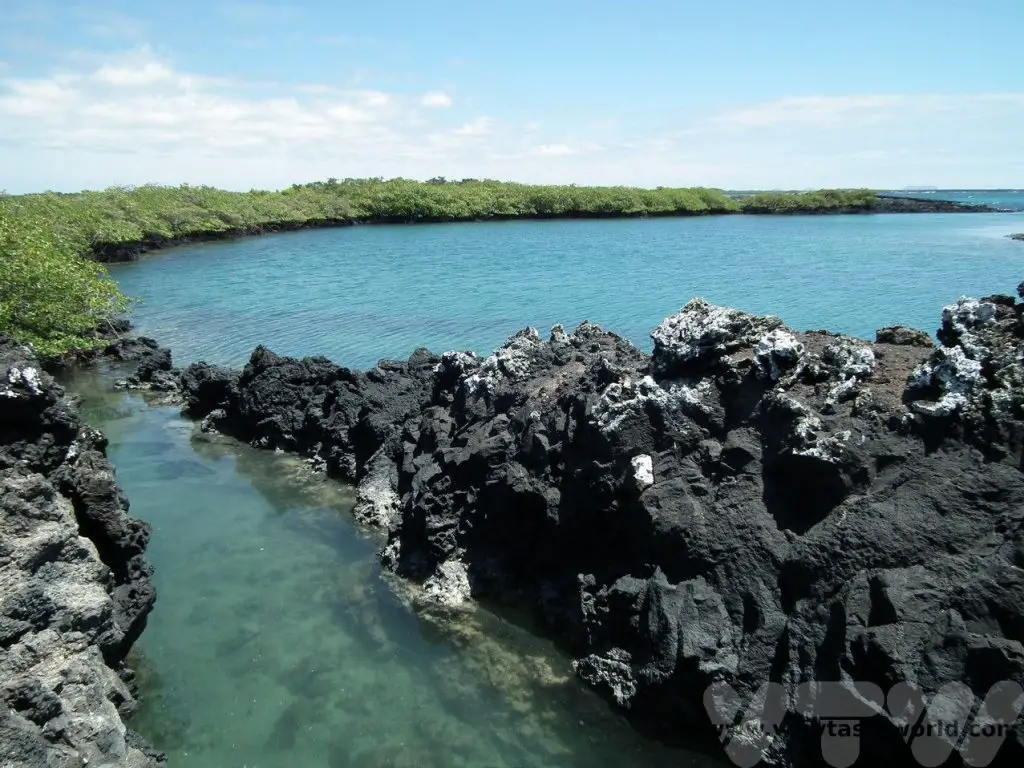
Lots of marine iguanas reside here. These are the only lizards that spend time in the water. They feed on algae at low tide and need to warm up in the sun. So they regulate their temperature by sunbathing.
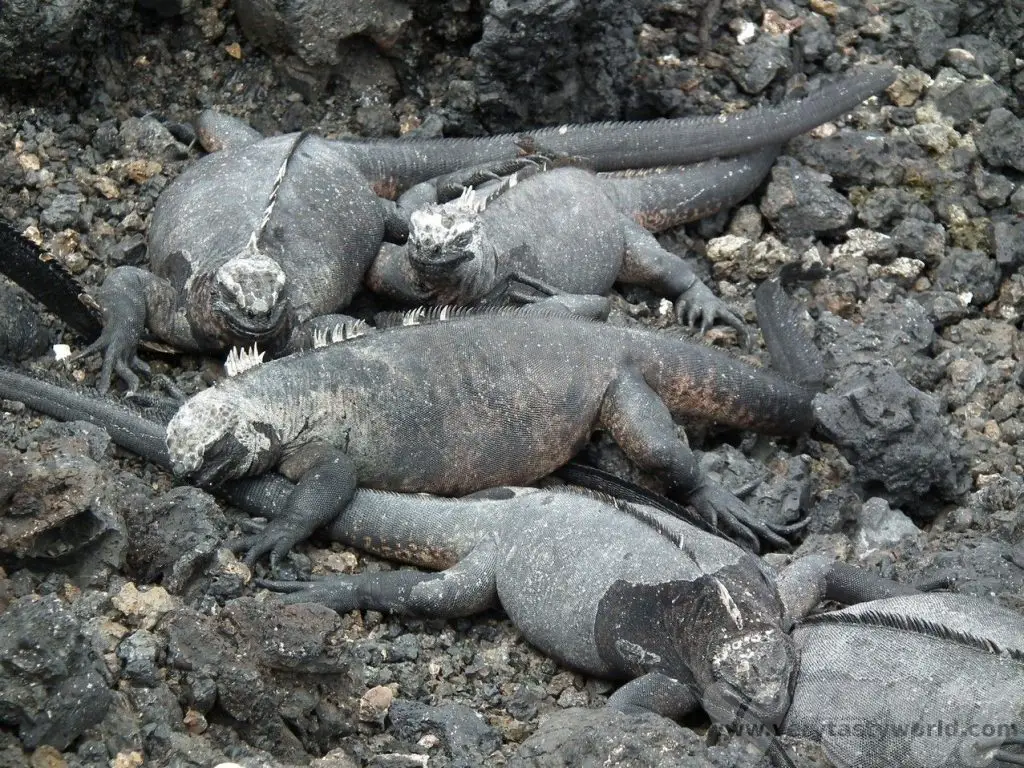

You can also watch them sneezing salt. Because they feed in the sea, they take in a huge amount of salt water, so they have special glands that remove it. They need to retain the water but expel the salt, so have developed this sneezing/spitting mechanism.
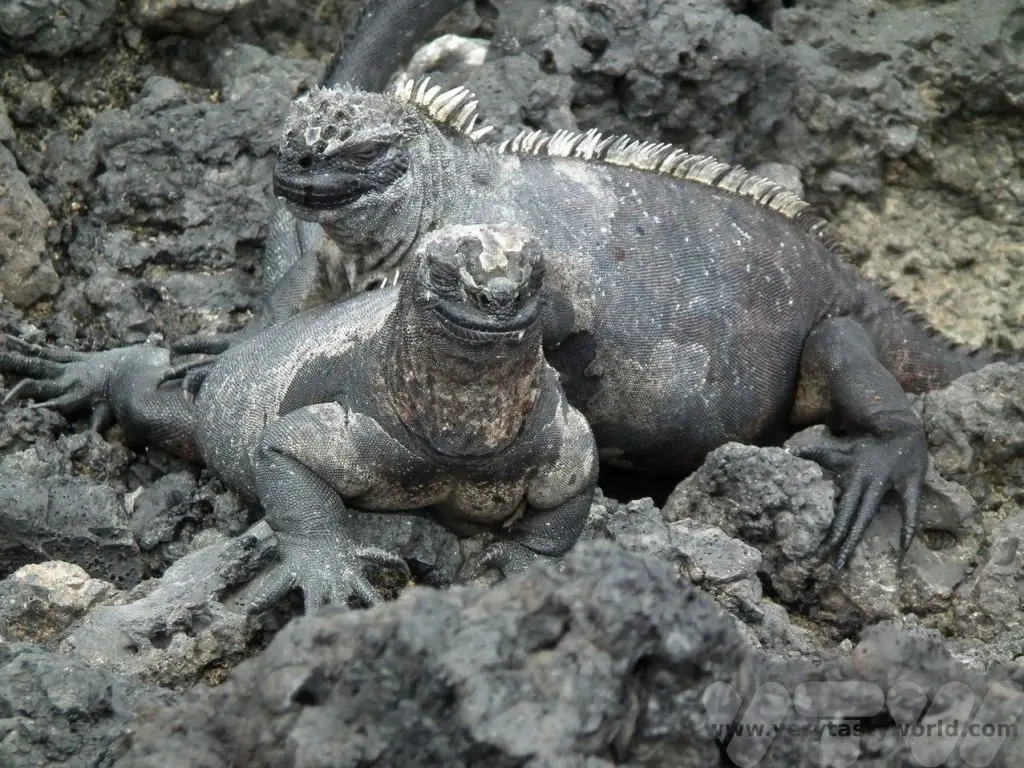
There is a bay where more tintoreras sharks hang out.
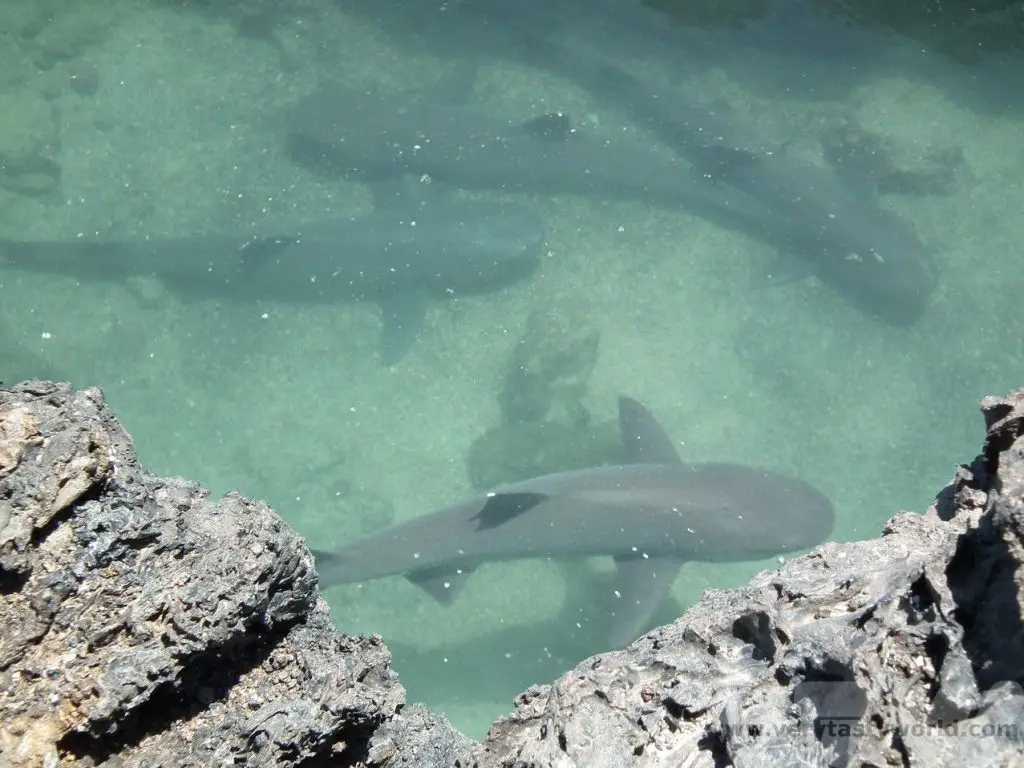
And some sea lions on the beach, some of which were feeling very vocal.
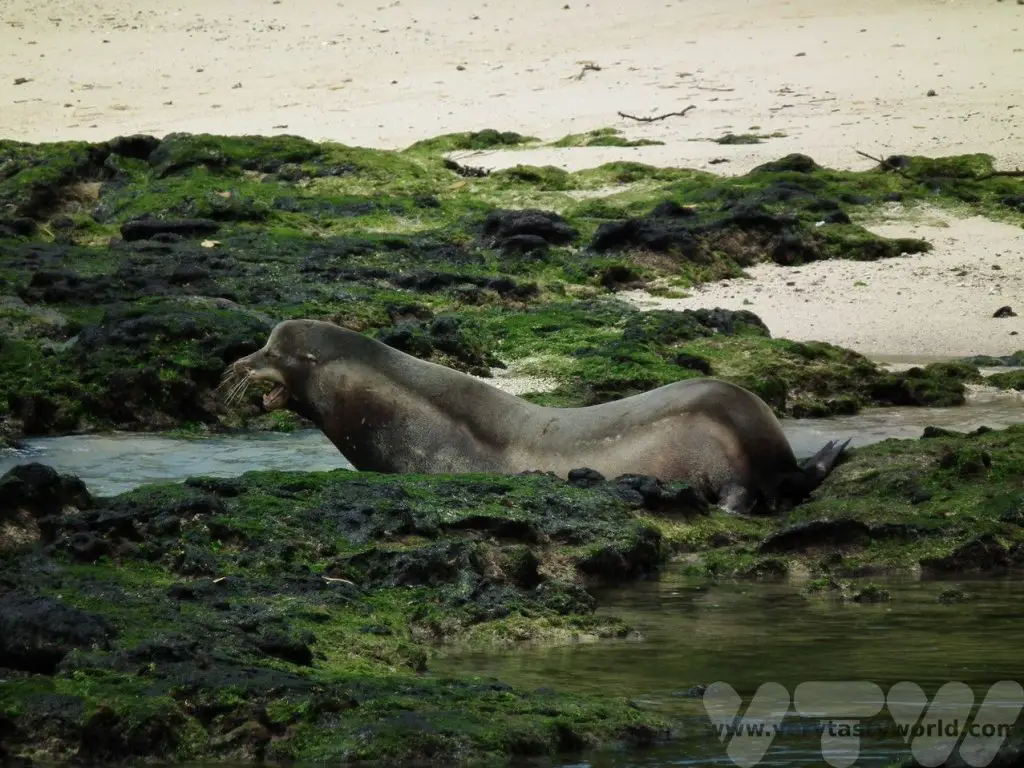
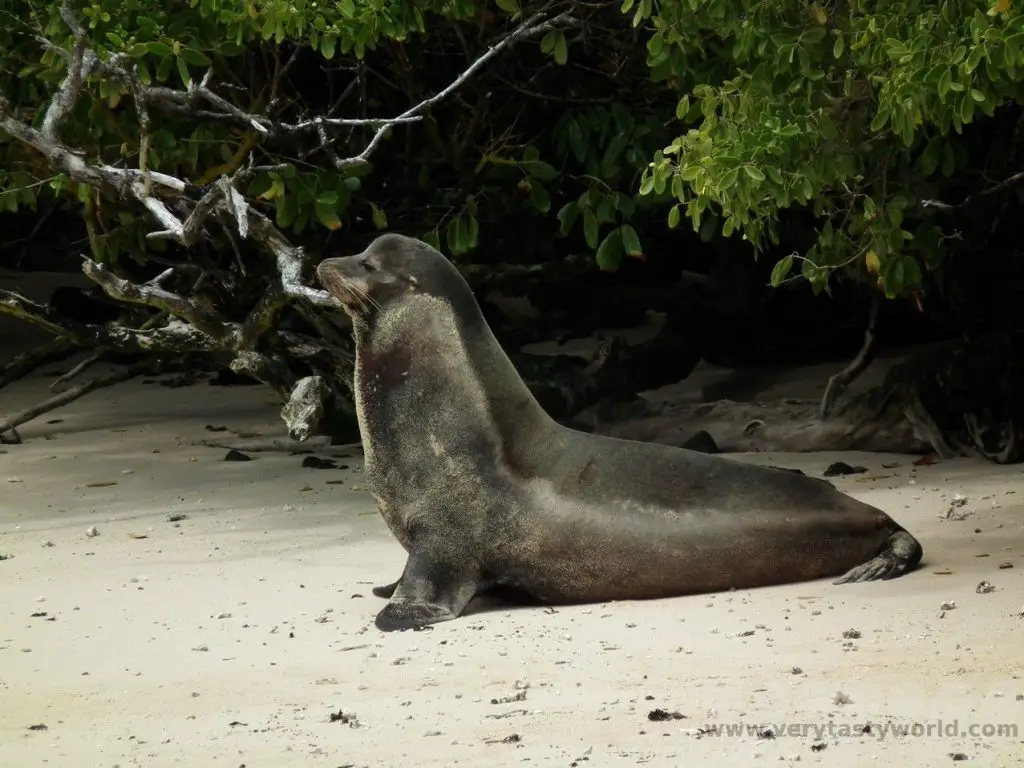
It’s possible to enjoy snorkelling in the shallow bay. If you’re lucky you’ll chance upon a turtle in addition to colourful fish and starfish.
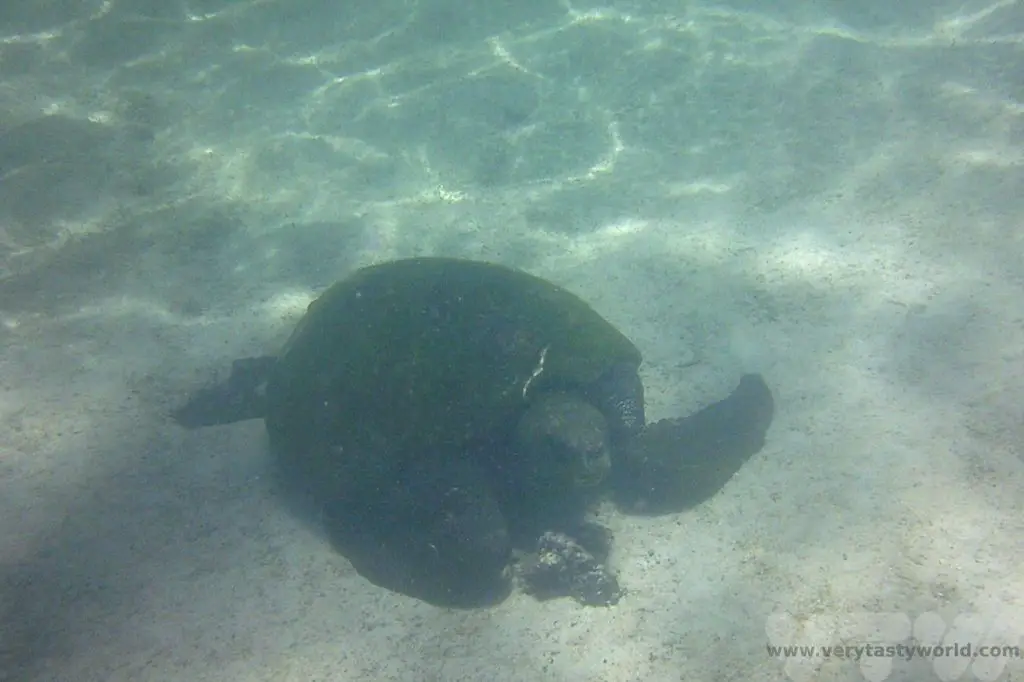
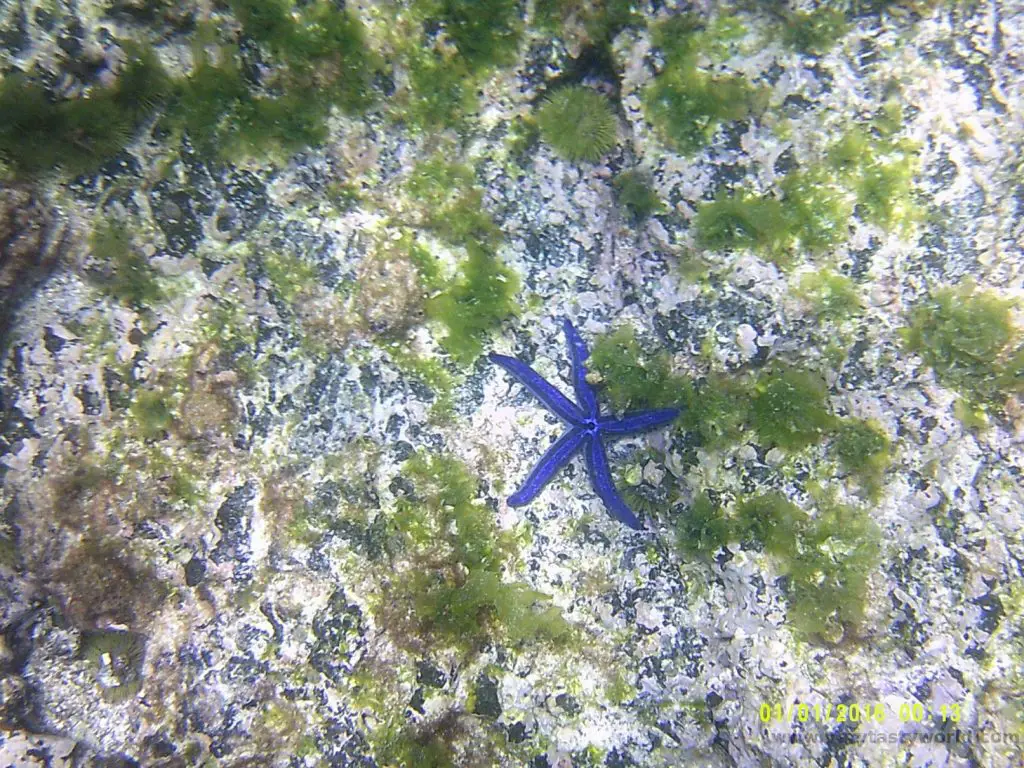
Then in the afternoon, we hired some mountain bikes and enjoyed cycling around the Humedales complex. This comprises a series of trails that you can explore. Be careful not to cycle over an iguana, they don’t really care for observing the trails as they sunbathe.
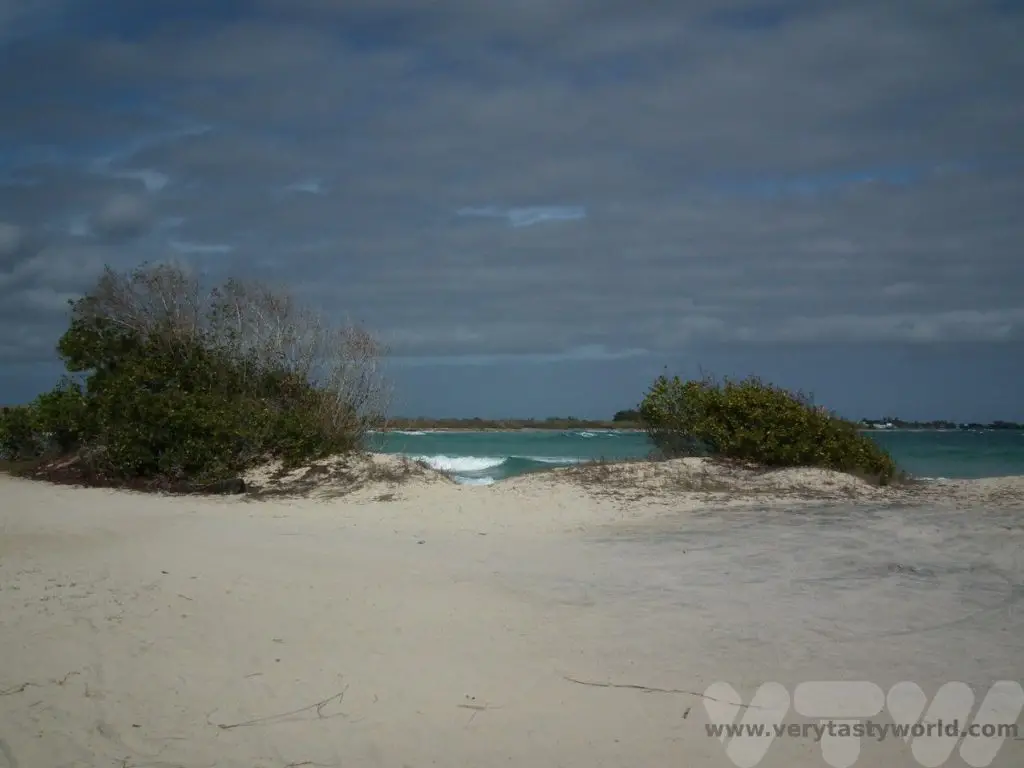
Other Things to Do on Isabela
A popular activity is to hike the Sierra Negra volcano. The name translates to ‘black mountain’ and this is an active volcano. Apparently it has the second largest caldera in the world. It’s around a 10km walk through volcanic landscapes with some interesting plants to see along the way.
Galapagos Land Based Itinerary – Five Days Based on Santa Cruz
We caught an early morning bumpy boat back to Santa Cruz. We managed to get a seat at the back of the boat this time, but it was on the right hand side, so got a thorough soaking. Still, it was better than being sick. Our itinerary allowed for a couple of days to explore Santa Cruz island itself and then enjoy day trips to other islands over the next three days.
We were based in Puerto Ayora, a compact town with plenty of choices for hotels and restaurants.
Day 3 On Santa Cruz
This trip took us to the centre of the island. First we stopped off at Los Gameles, twin volcanic craters that were once underground magma chambers following an eruption. Over the years they caved in, leaving these dramatic hollows.
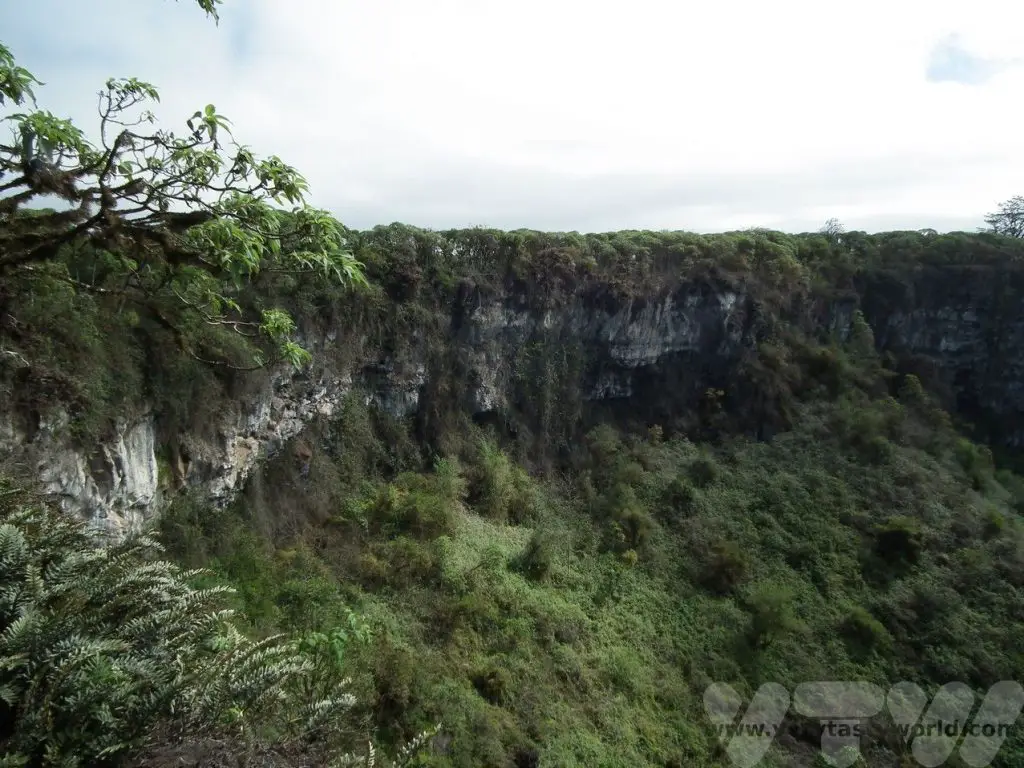
The interior of Santa Cruz is one of the locations where the famous Galapagos tortoises live. Indeed the archipelago was named for these remarkable creatures, ‘galapago’ meaning tortoise in Spanish. The tortoises are amongst the longest lived animals in the world; they can live for over 100 years in the wild and up to 177 years in captivity. There are tortoises to be found on seven of the islands and the differences in their observed shape and size contributed to the development of Darwin’s theory of evolution.

The tortoises are slow moving and spend much of their time grazing and also bathing in mud, clearly a very pleasurable life for them.
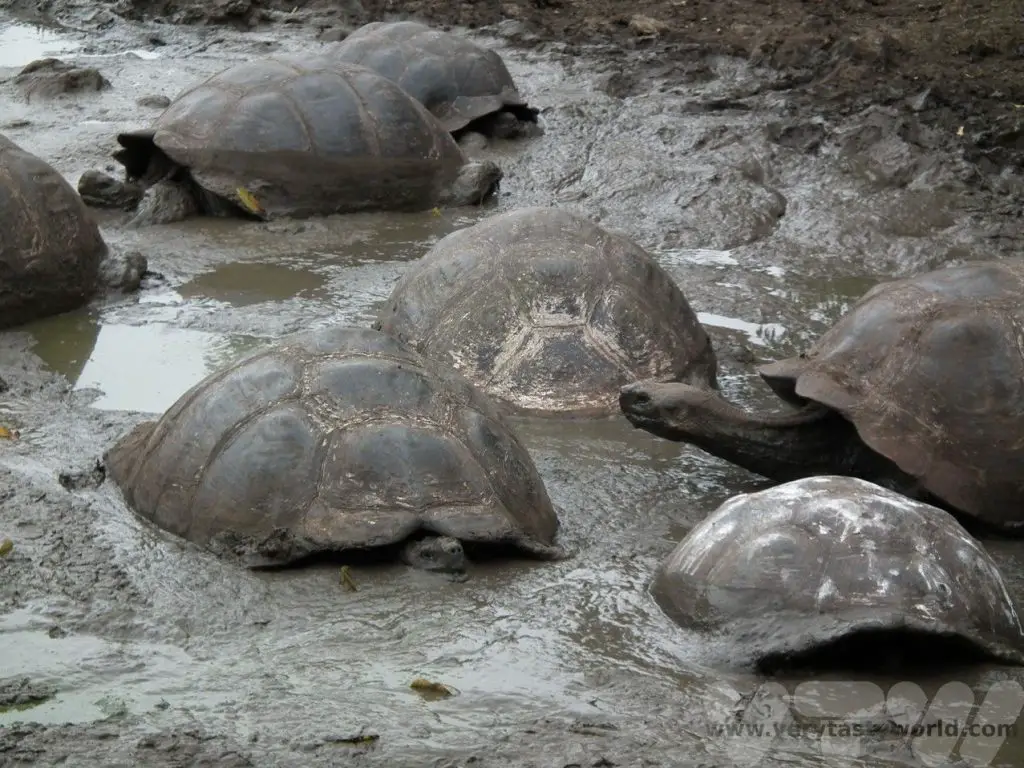

You are allowed to get within a couple of metres of the tortoise but no more. They are fascinating to watch.
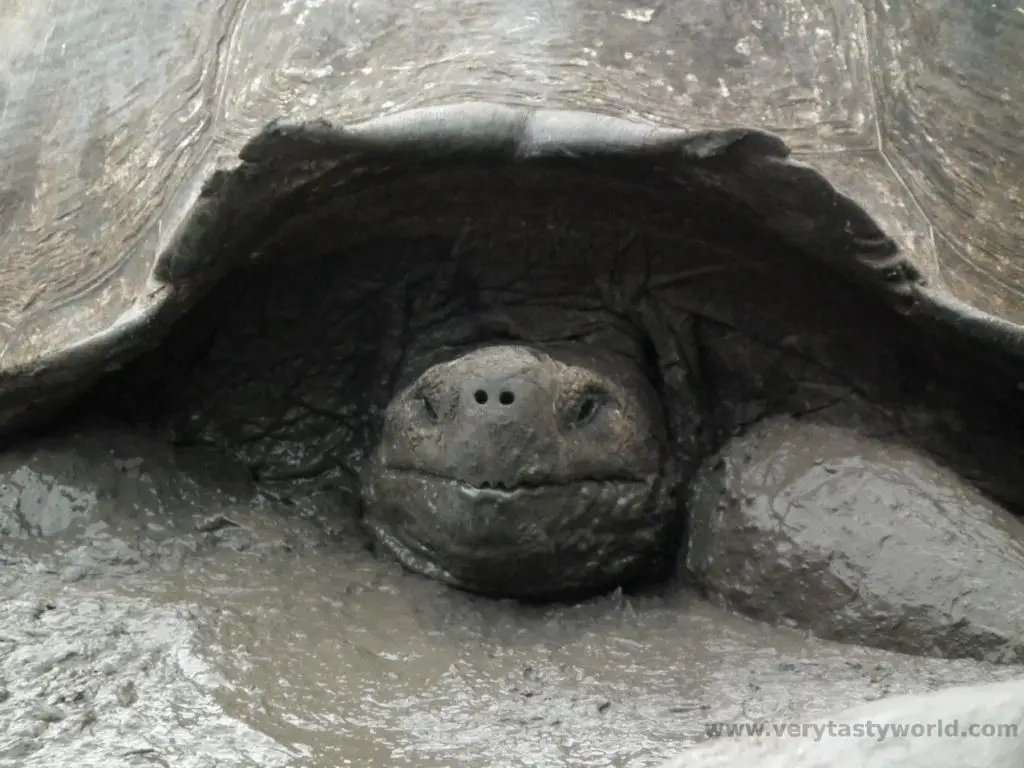
Day 4 on Santa Cruz
The morning involved enjoying a good walk and some beach time on the snowy white sands of Tortuga Bay Beach, just 45 minutes away from the centre of town.
Brava Beach has a wide beach to walk along where you can see marine iguana…
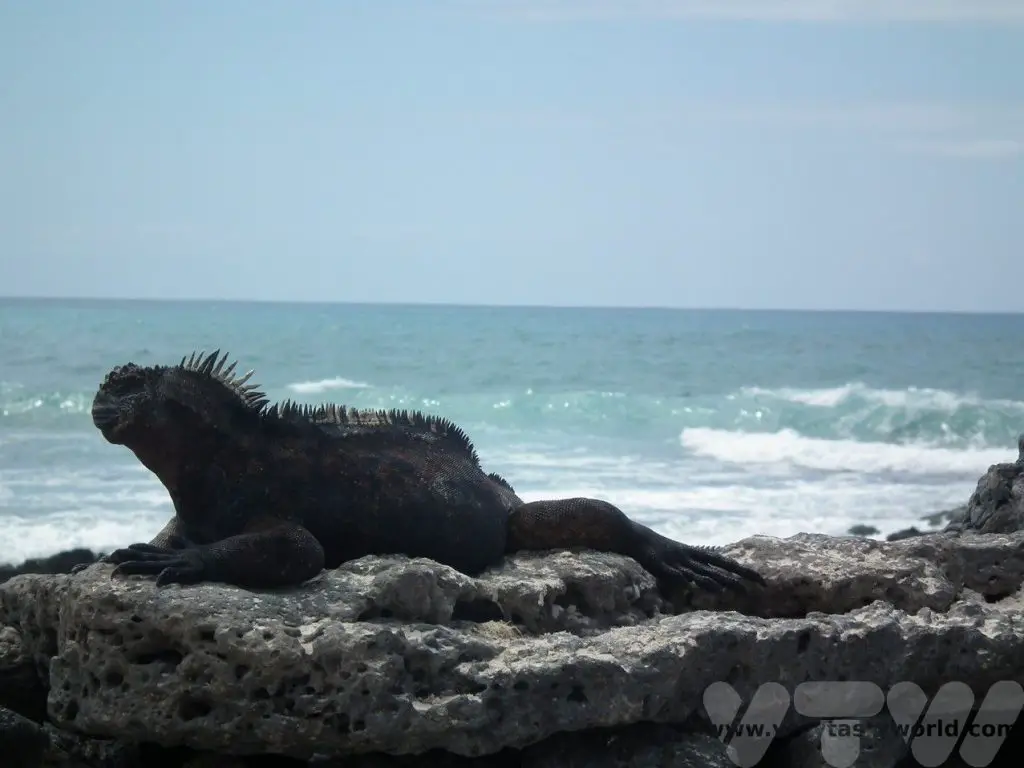
…and Playa Mansa has a natural pool surrounded by mangroves. It’s perfect for bathing.
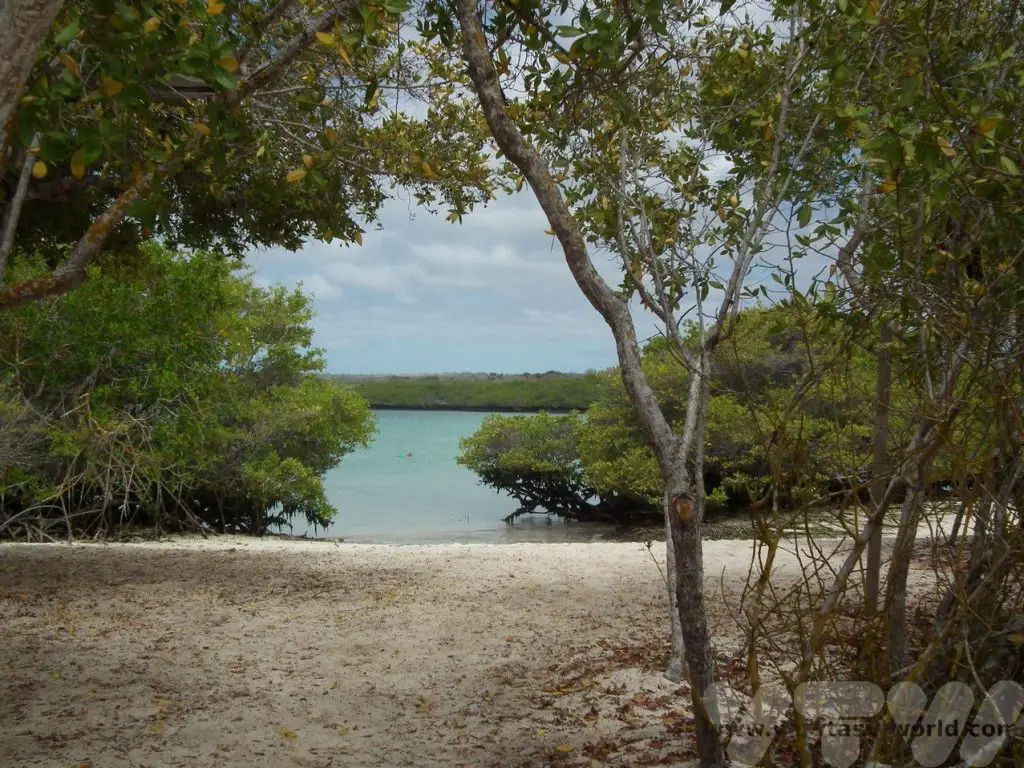
Later, we enjoyed a short boat trip around the bay. Then we visited the Canal del Amor view point and onto Punta Estrada where we could view the wildlife at Playa de los Perros.
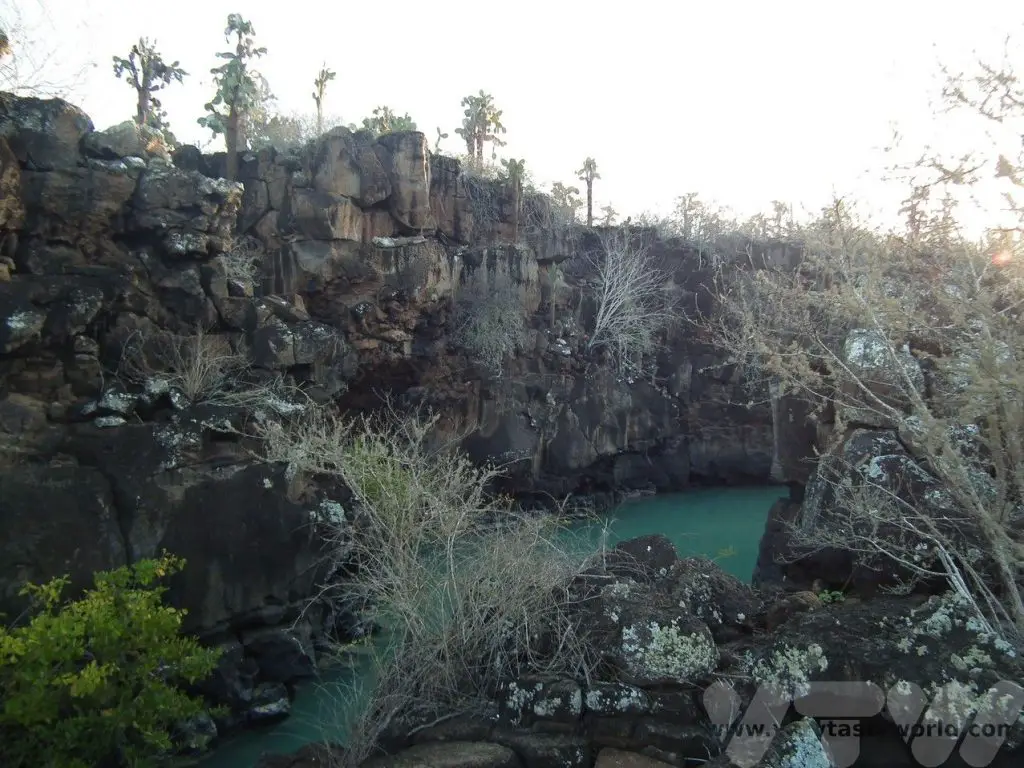
Three Islands to Explore From Santa Cruz
The next three days were dedicated to day trips to explore some of the islands closest to Santa Cruz. This involved a hotel pickup, and then a 45 minute drive to the Itabaca channel to our boat, the Queen Karen. This was a 16-seater boat which was perfect for the day trips – not too many people, just a nice group size for exploring the islands and enough to enjoy the company of other wildlife enthusiasts, for the day.
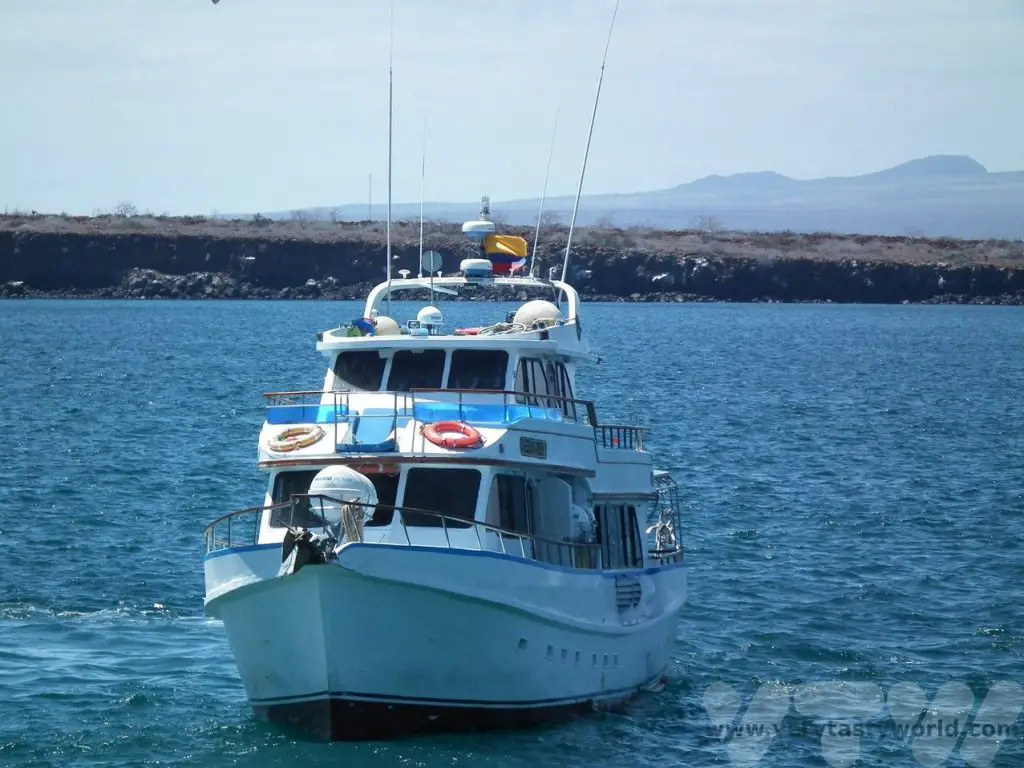
There are rules for visiting the islands in order to protect the wildlife and eco-system. You must stay with a registered guide and it is very important to remain on the paths, particularly during the breeding season because birds and other creatures may be nesting.
Day 5 North Seymour
North Seymour is a very short boat ride from Santa Cruz, just beyond Baltra (where the airport is located). This fabulous little island was a great place to see blue-footed boobies nesting.
This lady was sitting on her egg, totally unperturbed by the plethora of people parading past.
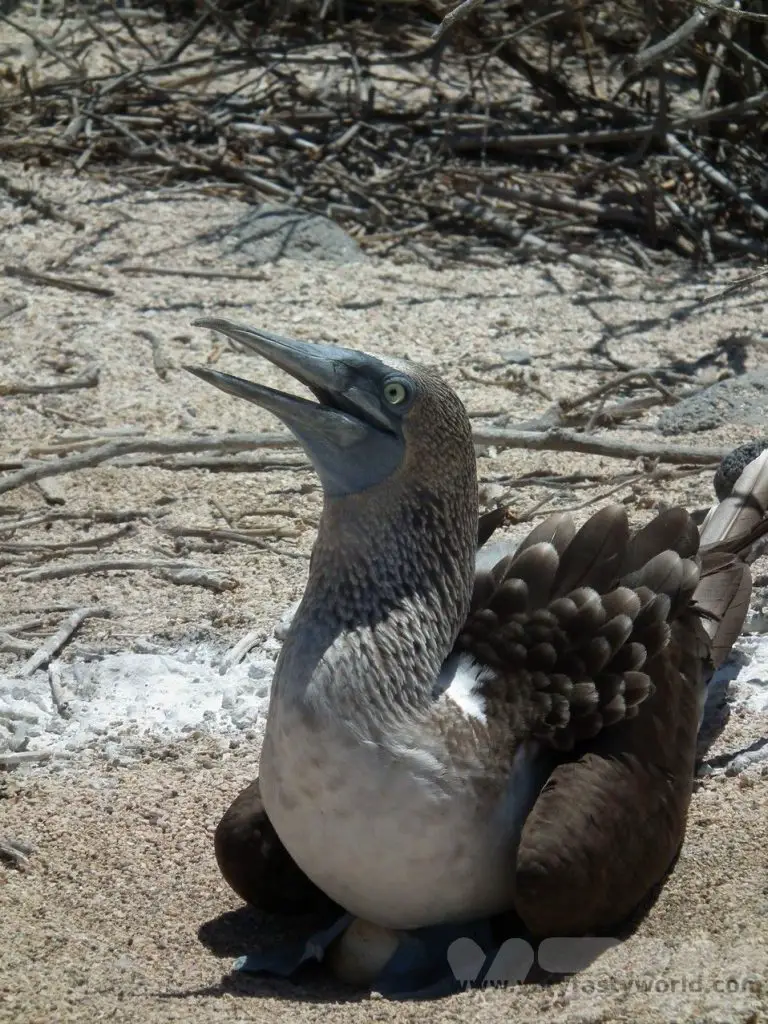
It was also the perfect time of year to see the Great and Magnificent Frigate Birds strutting their funky stuff. The males have a scarlet neck pouch which they inflate and parade about in the hope that the ladies will admire and choose to mate with them. One female was clearly enamoured!
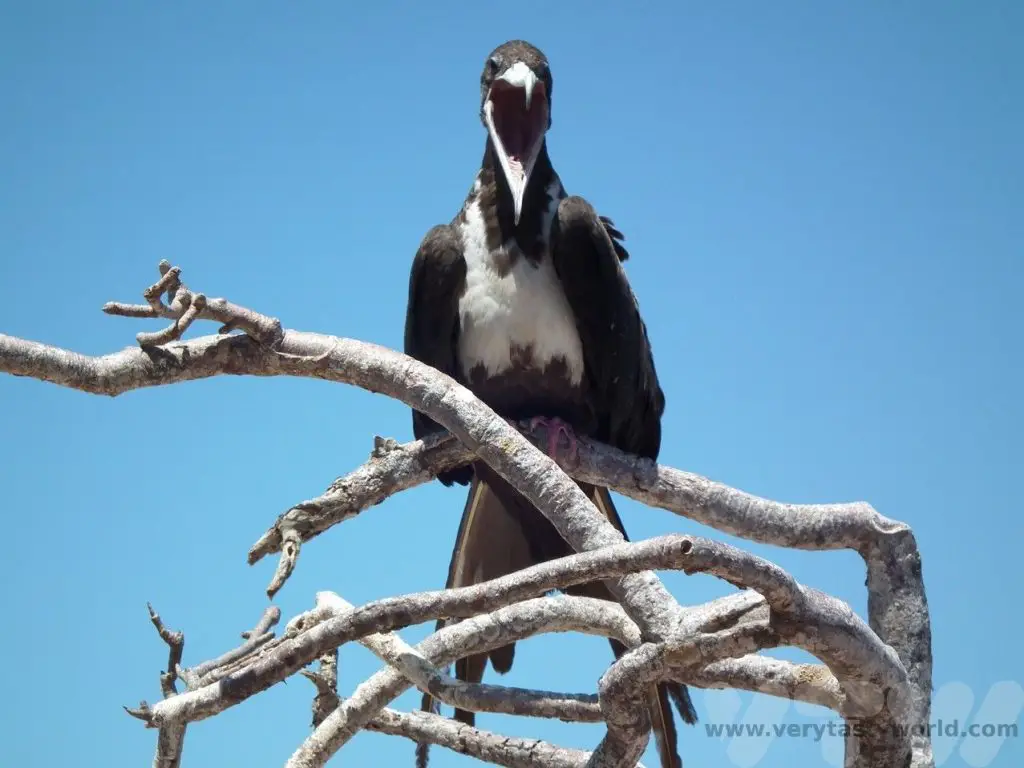
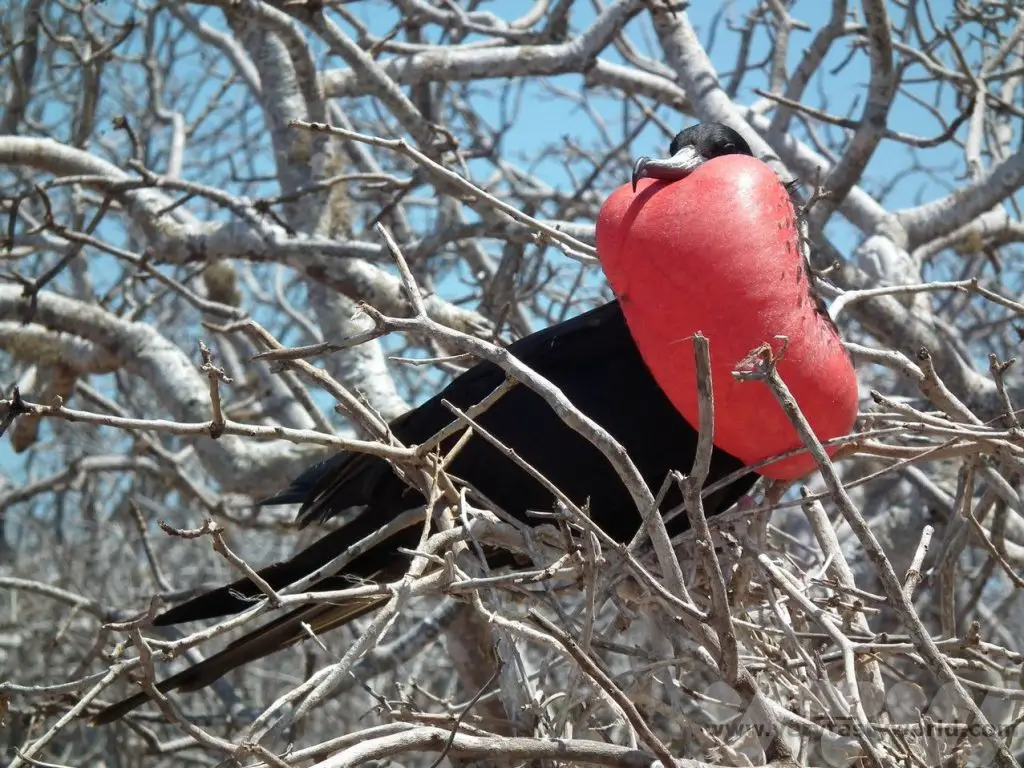
Day 6 Bartolome
Bartolome is a tiny island just off the coast of Santiago island. This was the longest day at sea – it took around two hours to reach this picturesque island from Santa Cruz. We were lucky that the sea was incredibly calm.
As we hopped off the boat to climb to the viewpoint we had to step over some Sally Lightfoot crabs and an obstinate but friendly sea lion.
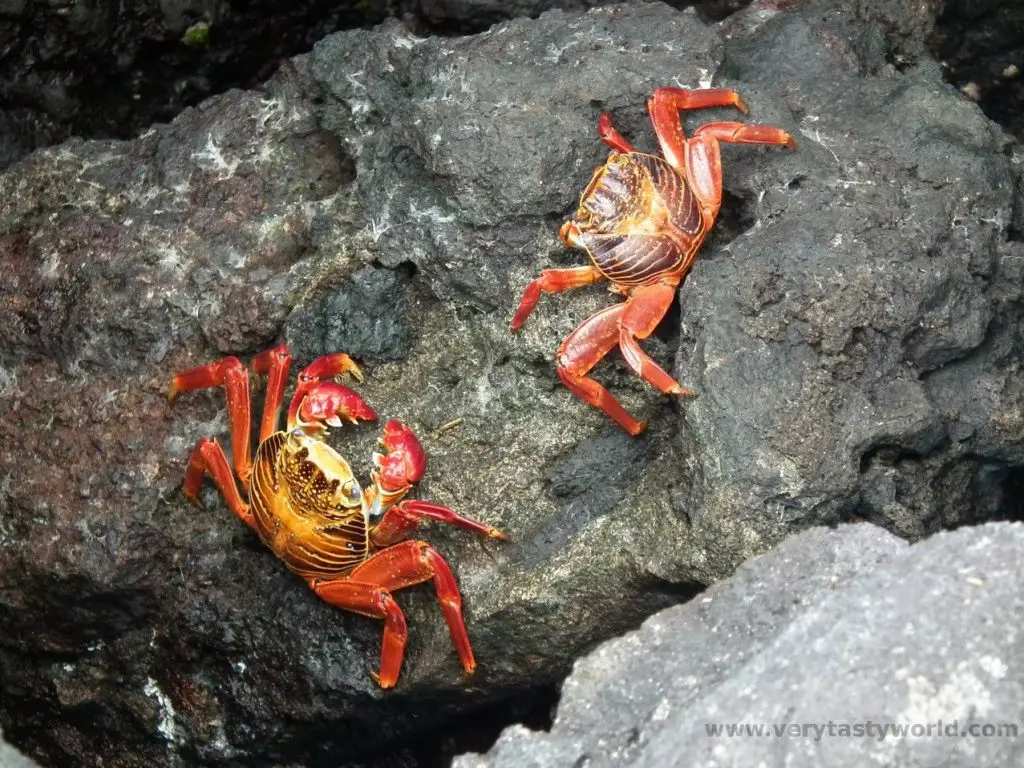
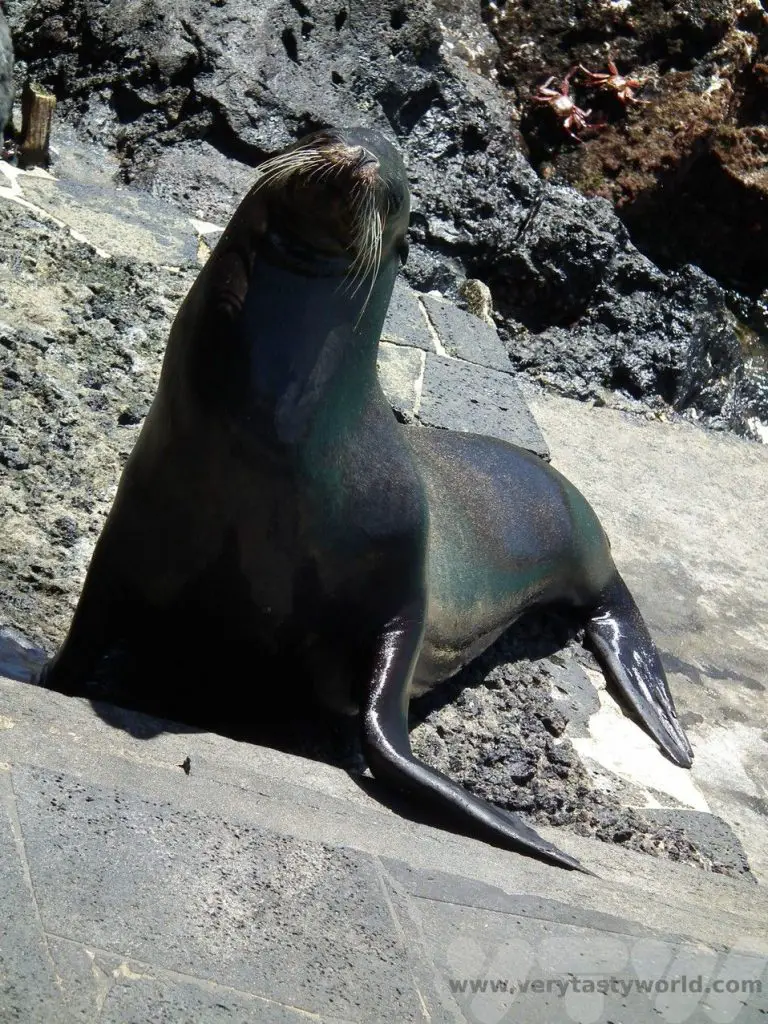
The climb to the top isn’t challenging and the view of Pinncale Rock from the top is lovely.
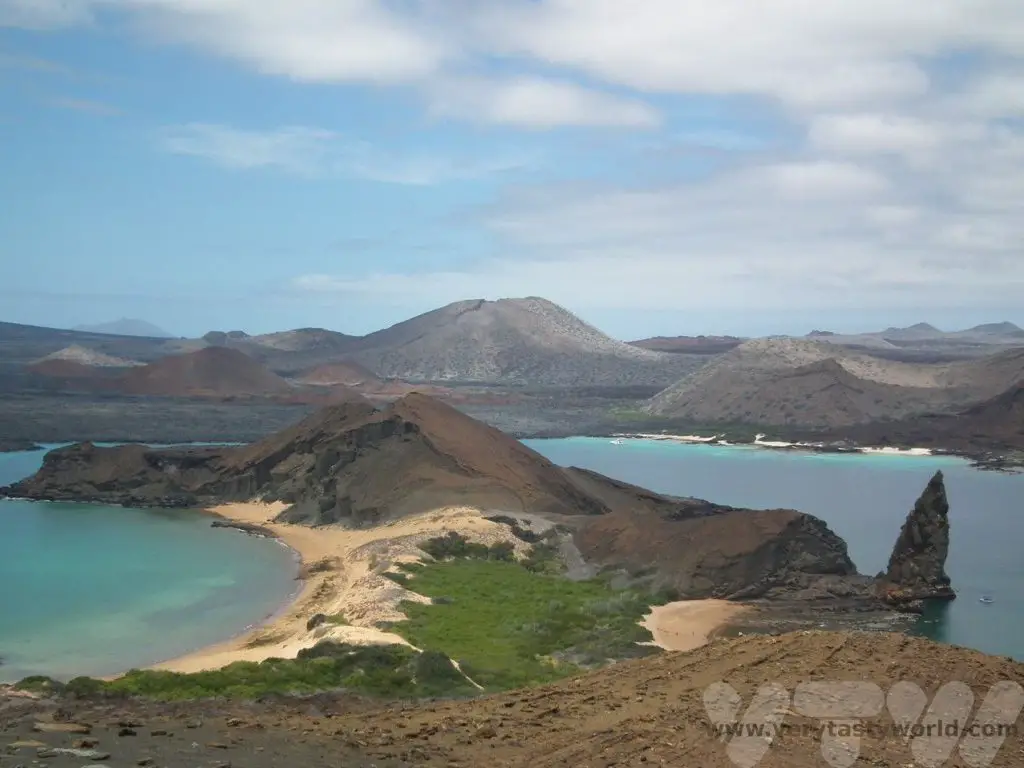
Then we hopped back on the boat to cross to Sullivan Bay to visit the lava fields on Santiago itself. You can really get a feel for the dynamic flow of the lava. This is relatively recent lava, believed to have flowed in the late-19th century. It appears frozen in time.

There was always an opportunity to go swimming/snorkelling and we enjoyed a couple of hours in the bay. The Galapagos are home to the world’s northernmost penguins, in fact, the only penguins that can be found in the northern hemisphere. The cold Humboldt and Cromwell sea currents mean that they are able to survive in the relatively warm temperatures. They are the second smallest penguin species.
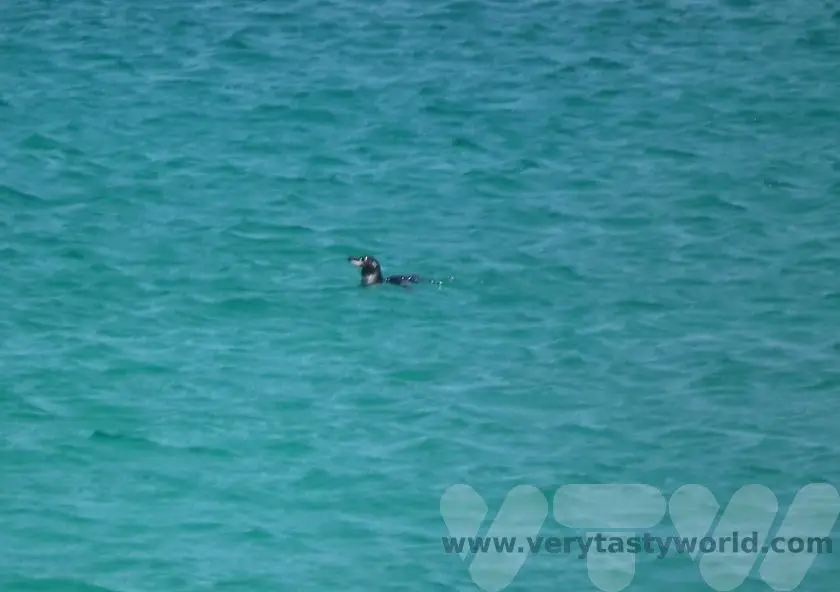
It’s a terrible photo but we did manage to capture a shot of one having a swim in the clear blue water.
Day 7 South Plazas
North and South Plazas are located to the east of Santa Cruz and we travelled along the Itabaca channel to reach them. The tide was perfect for us to land on South Plazas.
The landscape is gorgeous and the plant life here is very interesting. The ground is covered with the deep red of sesuvium and the prickly pear cacti provide a wonderful contrast.
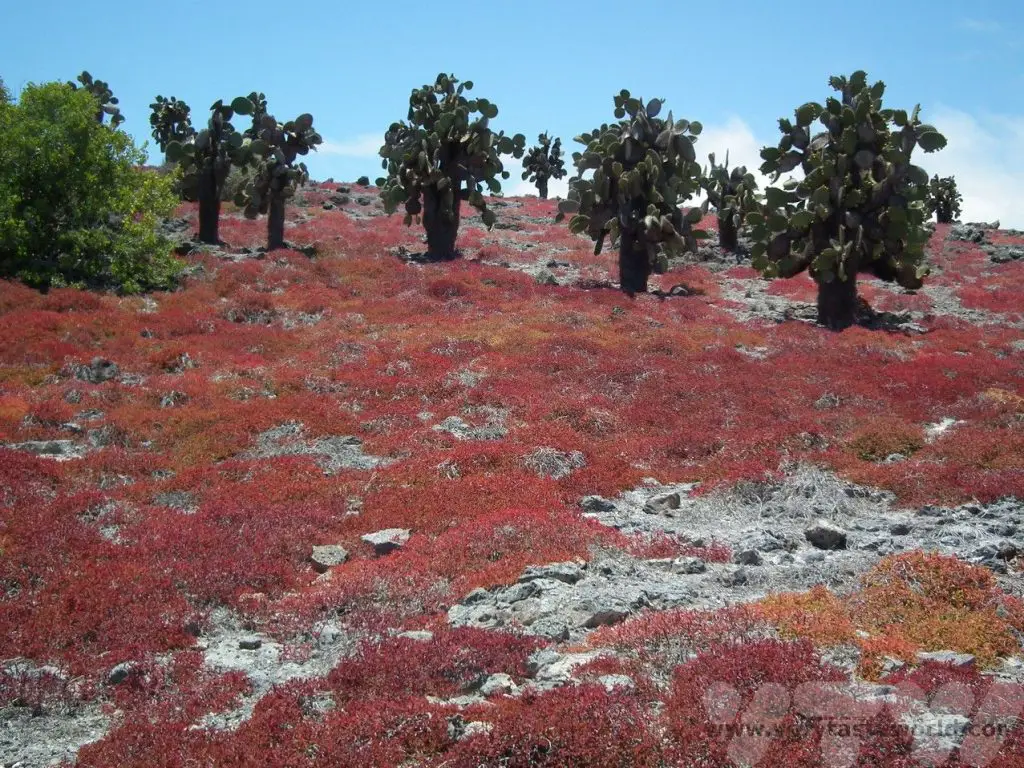
We saw land iguanas…
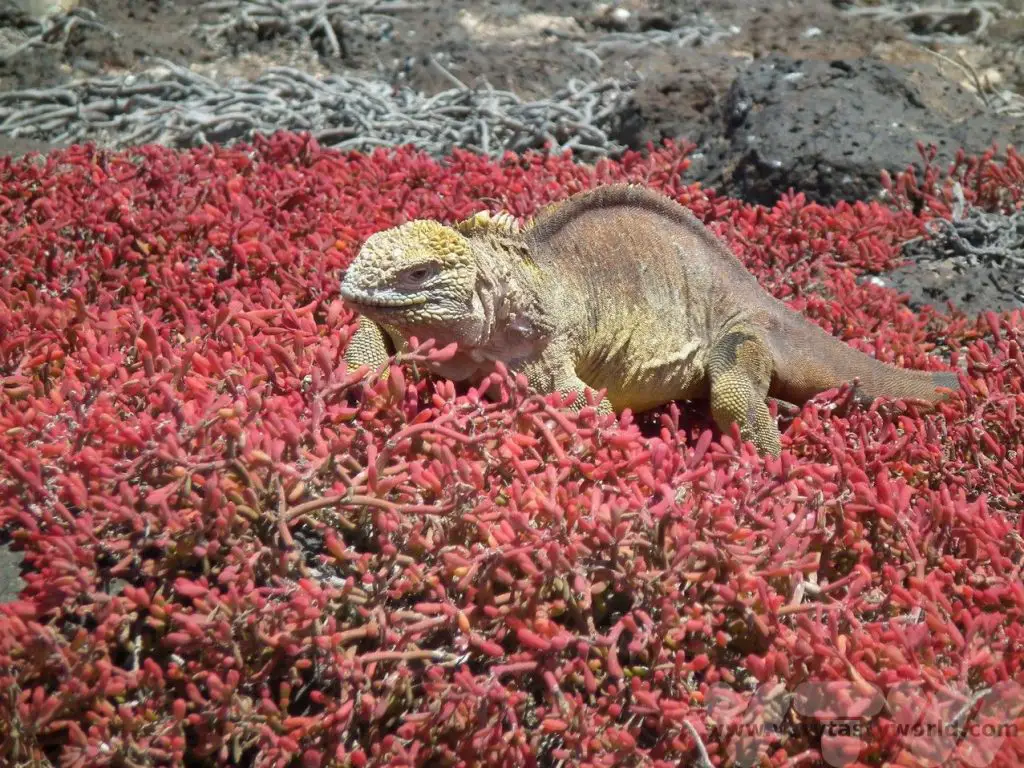
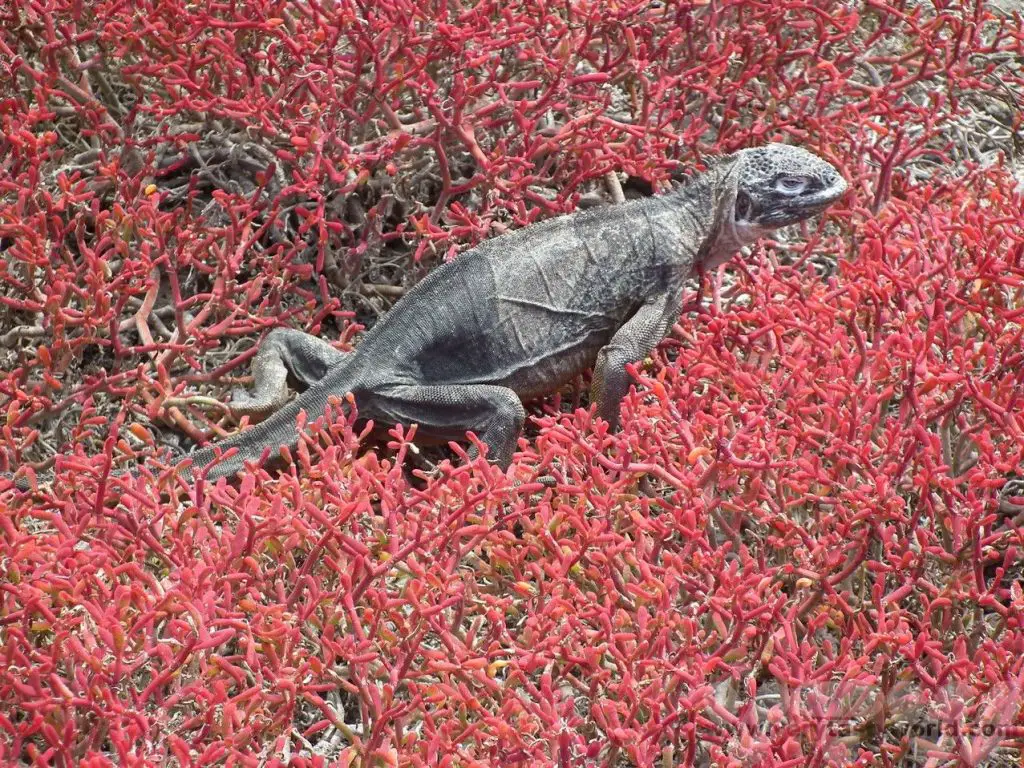
…Nazca boobies…
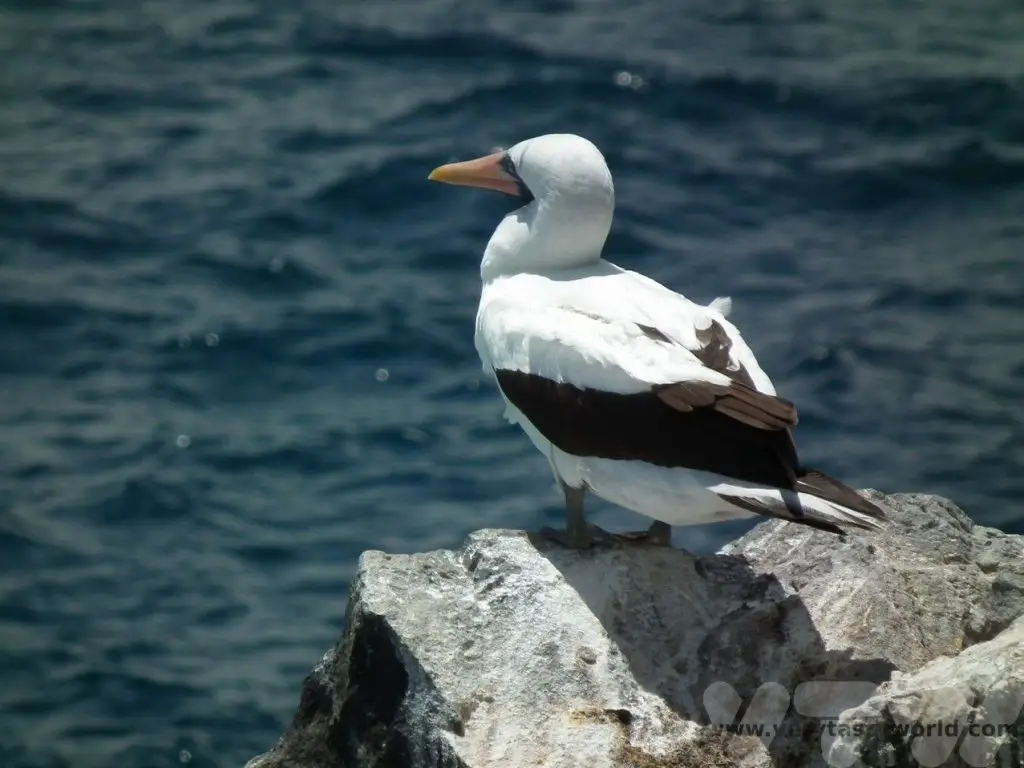
…and Swallow-tailed gulls making a nest. He is gathering stones as she looks on with approval.
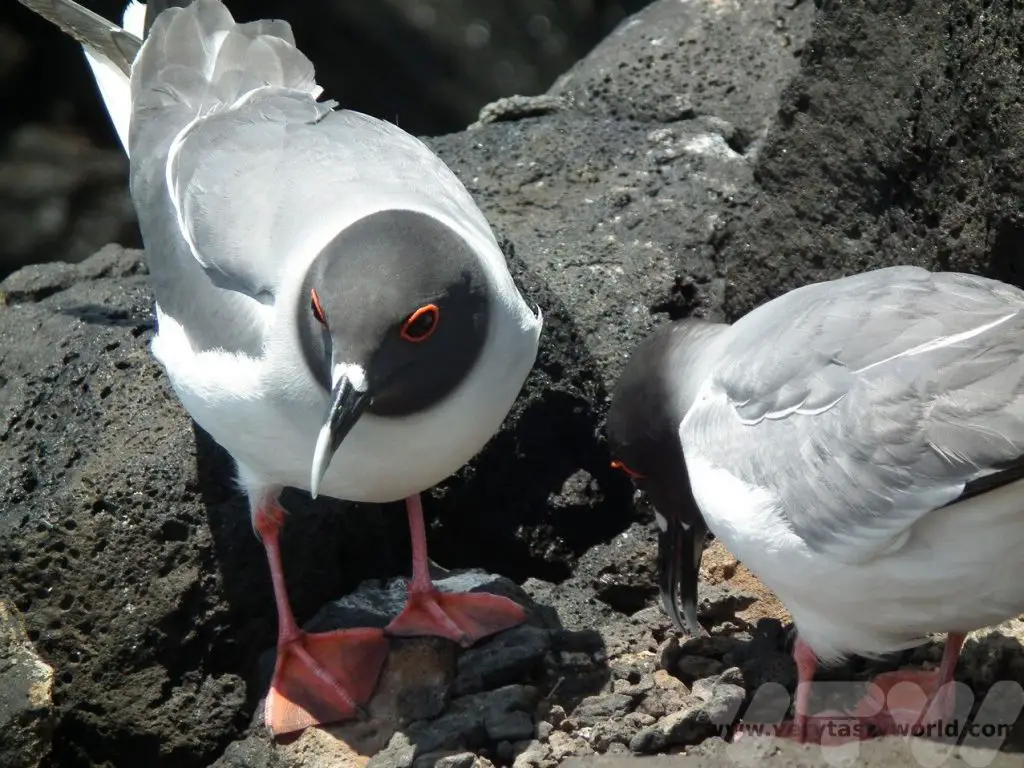
Along the shoreline we saw some sealions, including a baby. They were all very conscious of the local sharks patrolling the area.
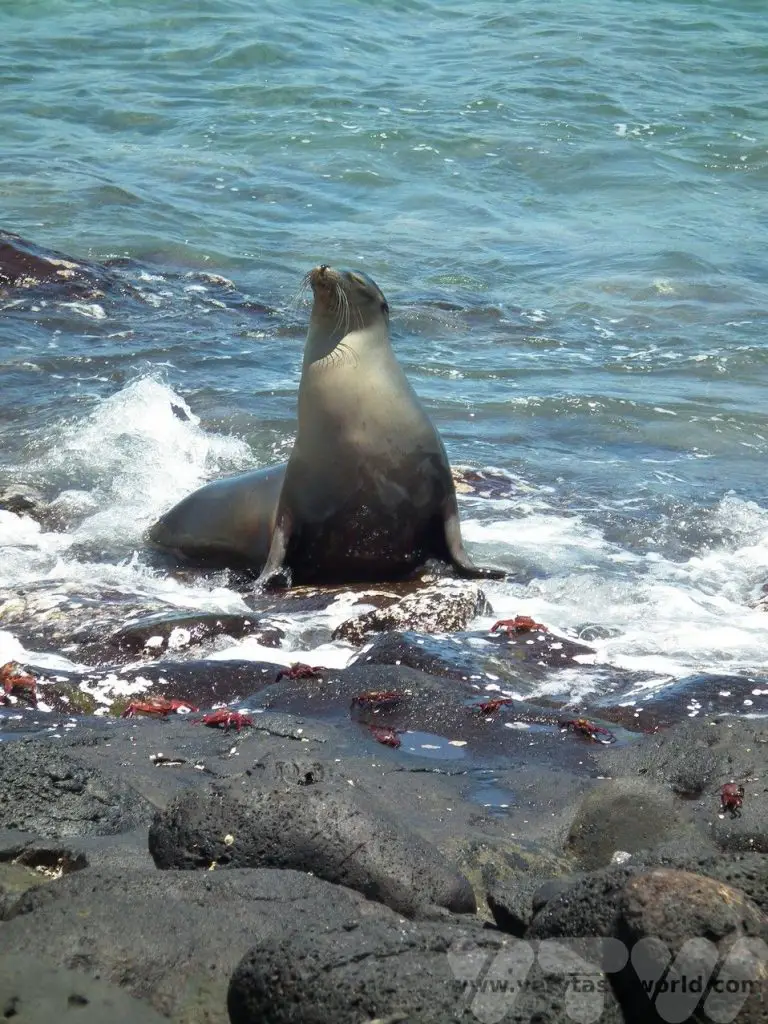
After the island visit we went snorkelling close to the Itabaca Channel to find some tintoreras sharks for ourselves. These sharks aren’t dangerous to humans and it was wonderful to bathe in the warm water and watch the sharks swim underneath us.
Galapagos Travelling Tips
Avoiding Boats Altogether
It’s impossible to avoid boats altogether if visting Santa Cruz as you need to cross the Itabaca Channel from Baltra island when you fly in. But that’s a very short and serene 10 minute journey. There are plenty of things to do on Santa Cruz – you will certainly see sea lions, iguanas, loads of birds and, of course, the giant tortoises. It is possible to fly between Santa Cruz, Isabela and San Christobal but costs are expensive.
Advantages of a Land Based Tour
If you can cope with going on a boat for a short time the day trips will ensure you get to experience the diversity of the islands as well as see lots of different species of wildlife. We managed to visit six islands whilst minimising our time on boats to a couple of hours at a time. The Santa Cruz to Isabela journey was definitely the worst trip but we were so pleased to have visited Isabela – it was amazing to see the wildlife there, especially the boobies.
Obviously budgets vary from person to person, but a land based tour can also be cheaper. We often find that local companies are able to offer good deals on accommodation and/or excursions. We do recommend booking excursions in advance though, especially if you are likely to be travelling in the busy season.
If you’re staying in Santa Cruz, there are lots of options for places to eat and plenty of hotels in Puerto Ayora. Enjoying excursions during the daytime means that there is time to explore the local area, dine out and enjoy a drink or two in the evenings.
Land-based tours are more flexible and you can change the itinerary if you wish (and there is availability). You can also schedule in some relaxation, especially if you wish to enjoy time on the beach.
Disadvantages of a Land Based Tour
The biggest disadvantage is that you won’t be able to reach the further islands. Cruises are pretty efficient in that you can sail during the night to arrive at an island in the morning and thus have more time to explore.
Another advantage is that, although cruises can be expensive, they are usually fully inclusive, so you know how much you will be expecting to pay for your trip, whereas with land based tours you will need to account for additional spending money.
When to Visit the Galapagos?
The Galapagos region has two main seasons: June to November are cool and dry whereas December to May are hot and rainy. High season runs from June to early September, then mid-December to mid-January.
There is not really a bad time to visit the Galapagos. The nature is simply spectacular all year round but if there is a particular animal or bird you wish to see it is worth checking when they are most likely to be observed.
If you are cruising, consider how rough the sea might be. August and September are likely to have the choppiest waters, although cruises will still be available at that time. (There might be discounts available.)
It’s also worth thinking about which creatures you might see at a particular time of year and what they are likely to be doing. We visited during the breeding season for many of the birds, so saw the males showing off to their mates – it was particularly lovely seeing the blue-footed booby courtship ritual. Other times of the year you will see young birds and animals. Different creatures will have different breeding seasons. And some migratory species will only visit at a particular time of year.
What Costs do I Need to Consider?
Aside from transport, accommodation, food/drink and excursions, there are a number of compulsory fees. Current costs per person are:
Galapagos Entry Fee (payable on arrival) $100 US
Isabela Docking Fee – $10 US
Migratory Control Card – $20 US
Transportation Baltra Airport – Itabaca Channel – $5 US
Transportation Itabaca Channel – Baltra Airport – $5 US
Water taxi from dock to boat (depending on the tide) – $ 1 US per person per ride
Money
Ecuador’s currency is the US dollar, so no need to worry about exchanging currency if you are travelling from the USA.
There are cash machines on Santa Cruz but they are not always reliable, so we suggest taking cash. There are no cash machines on Isabela.
What to Bring
Aside from your usual clothes and toiletries we recommend:
Swimming gear as there were a lot of excursions where we jumped off a boat into the clear blue sea. We didn’t need wetsuits as we found the water to be delightfully warm, but then we are used to swimming in the cold English Channel. If you think you are likely to feel the cold you can usually hire a wetsuit from the tour company. But we did wear a t-shirt over our conventional swimwear so as to protect our backs and shoulders from the sun. (We tended to wear the previous day’s smelly old t-shirt in the sea then rinse it out in the hotel bathroom.)
If you wear glasses it’s worth considering getting prescription goggles for snorkelling. Colin was massively disappointed, not that a 2m long shark swam beneath him, but because he was too short-sighted to see it!
Sun protection – sunscreen (we recommend at least Factor 30+ and also consider using waterproof sunscreen that is kind to the marine environment) and a sun hat. The sun is strong in this part of the world and you can get burned easily, even on a cloudy day.
Waterproof/beach shoes/flip-flops. There are a lot of opportunities to spend time on beaches or rocky outcrops. Waterproof shoes are also useful when you are changing into and out of swimming gear when snorkelling.
Travel towels are useful, although some tour companies can provide towels.
Camera with a decent zoom. If you have a waterproof camera bring that along. If you don’t have a waterproof camera we reckon it’s worth investing in one, even if it’s a cheap one. We enjoyed snorkelling on most of the excursions and coming face to face with a turtle or a shark is such a magical experience you’ll want to capture that moment. A phone camera may well be just fine for you, we appreciated having a wrist strap as we were on boats a lot and didn’t want to drop the phone into the water.
If you are prone to seasickness, consider whether there might be remedies that might help. There are all sorts of options, from pills to wristbands to patches. These will likely be personal for you.
Bring your regular medication including some spares. You may find that the medical facilities on the islands are more limited than in your country. Also consider whether you have suitable travel insurance for your needs.
Internet
It is possible to access the internet on Santa Cruz but it’s not great on Isabela. Enjoy being offline for a while!
Dining on the Galapagos
You’re most definitely visiting the Galapagos for the wildlife and not the food! But the main towns of Puerto Ayora on Santa Cruz and Villamil on Isabela have a variety of restaurants which offer menus to suit varying budgets. Seafood was plentiful and we found a few places that offered good value meals.
It’s fun watching the fishing boats come in to land their catch at the seafood market in Puerto Ayora. There will always be plenty of birds – and sometimes a sea lion – waiting for any random tidbits that might come their way.
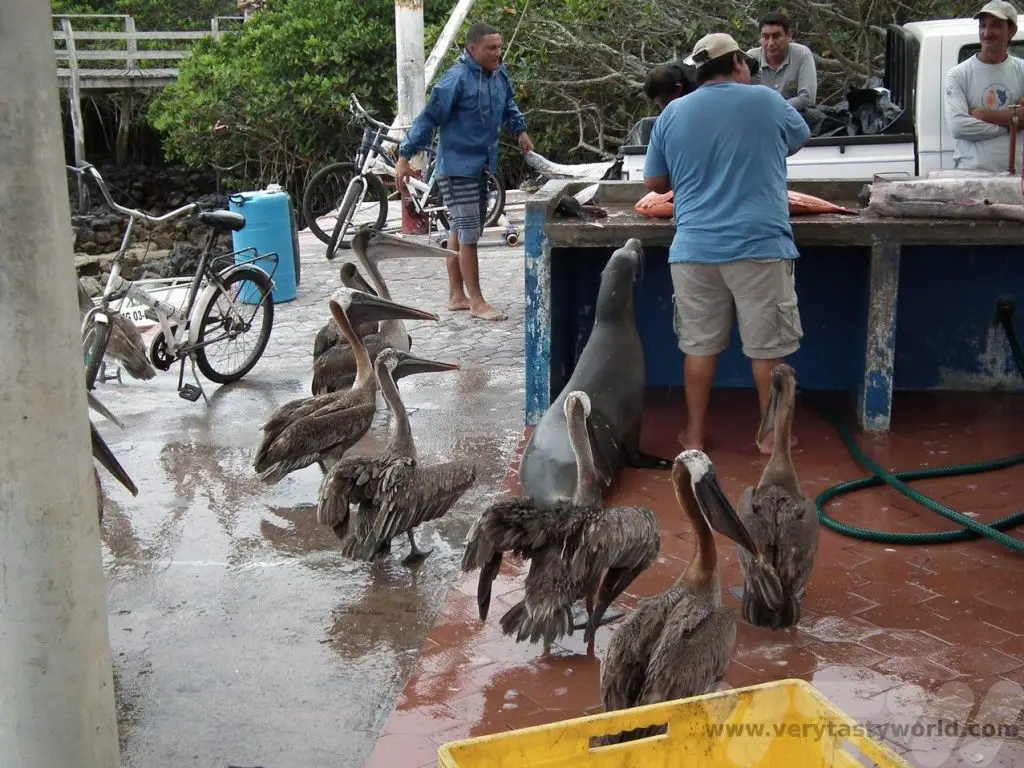
Related Posts You May Enjoy

- Rivers and Rainforests – A Guyana Itinerary
- Best Time To Visit Machu Picchu 2024 Update
- A 2 Week Patagonia Itinerary
- Day of the Dead in Campeche
- A Galapagos Land Based Itinerary
- RECIPE: How to Make Costa Rica’s Gallo Pinto
- A Tasty Puebla Food Tour
- Costa Rica Wildlife Sanctuary – Caño Negro
- Visit Torres del Paine National Park in Patagonia
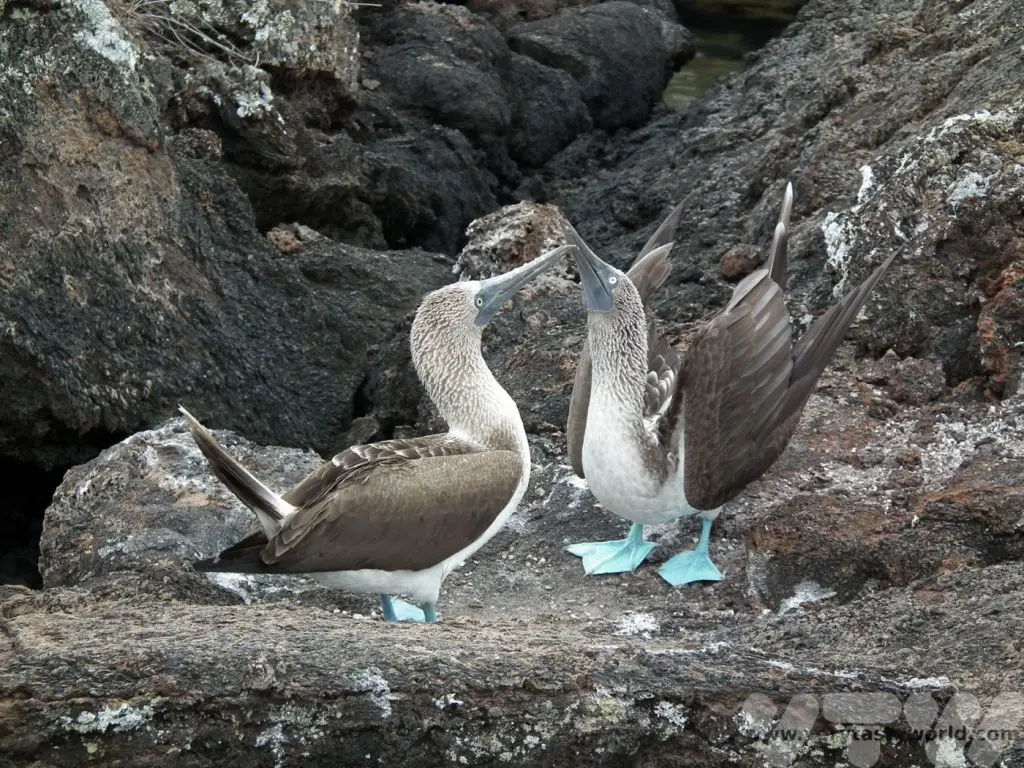

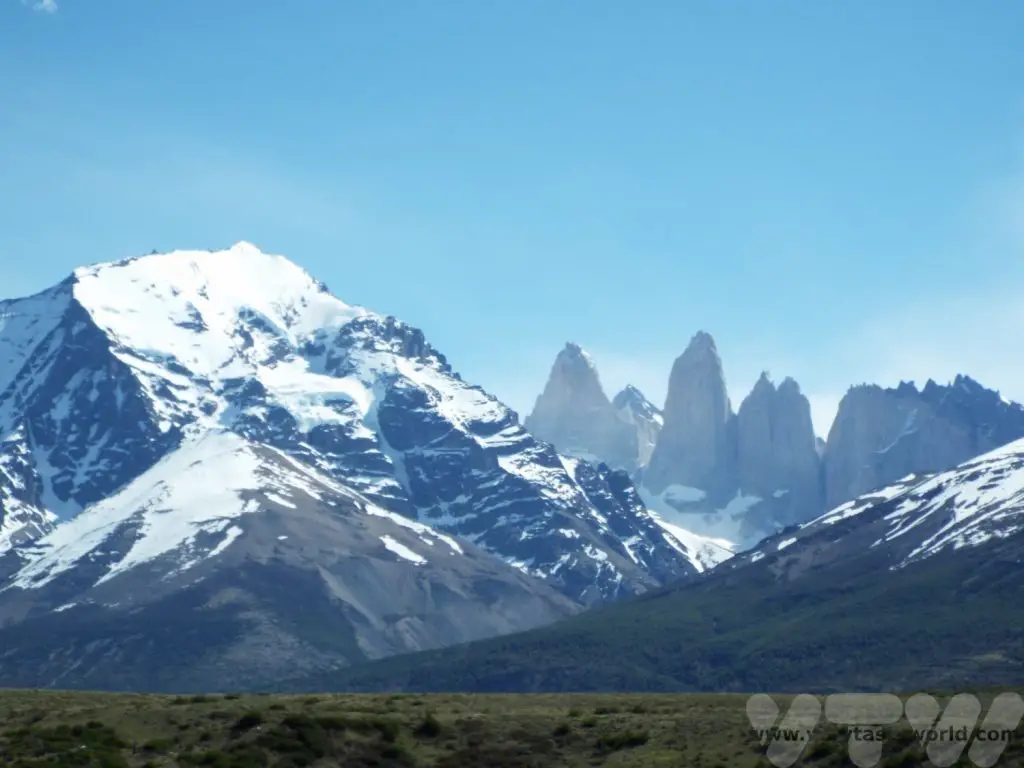
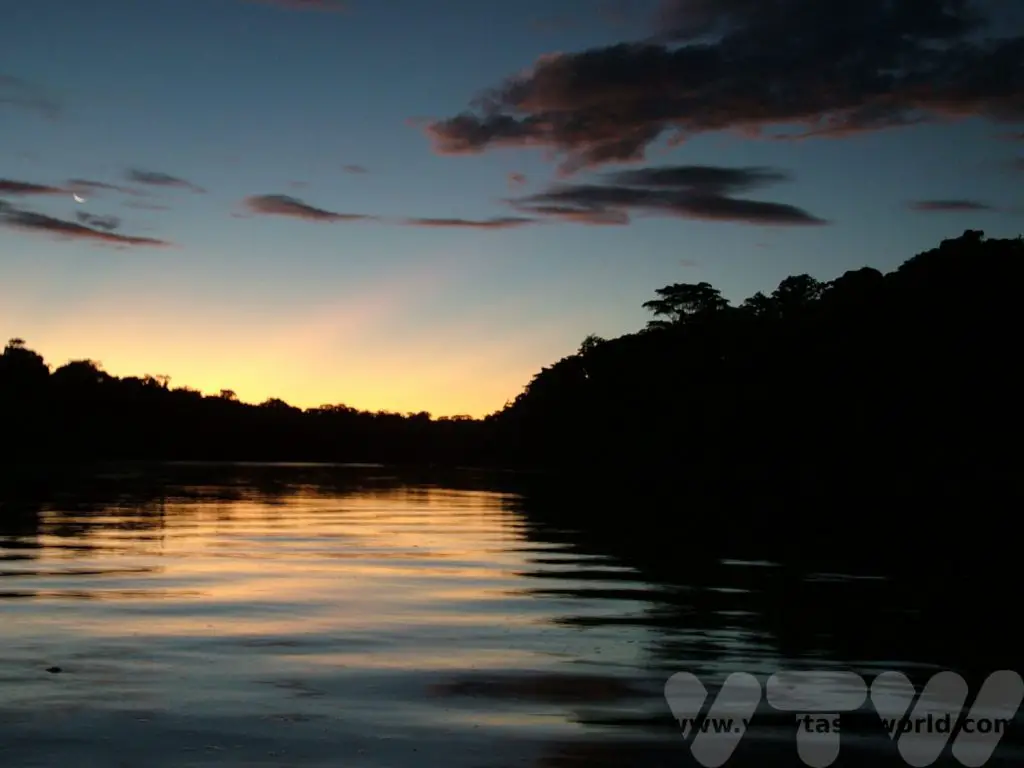
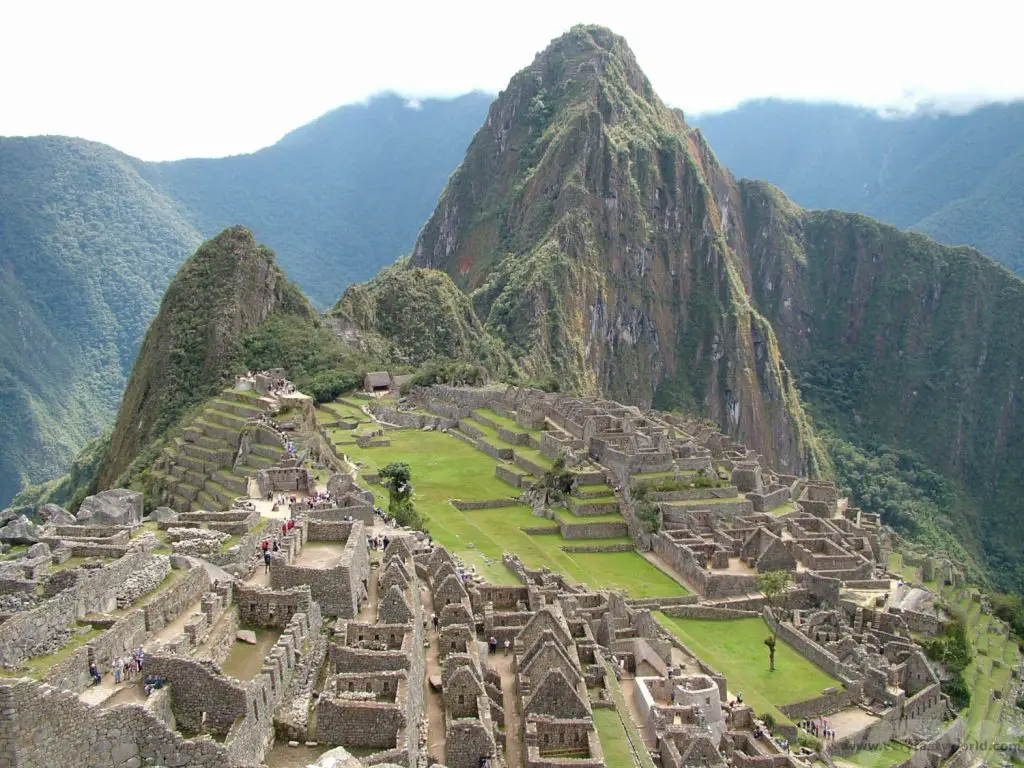
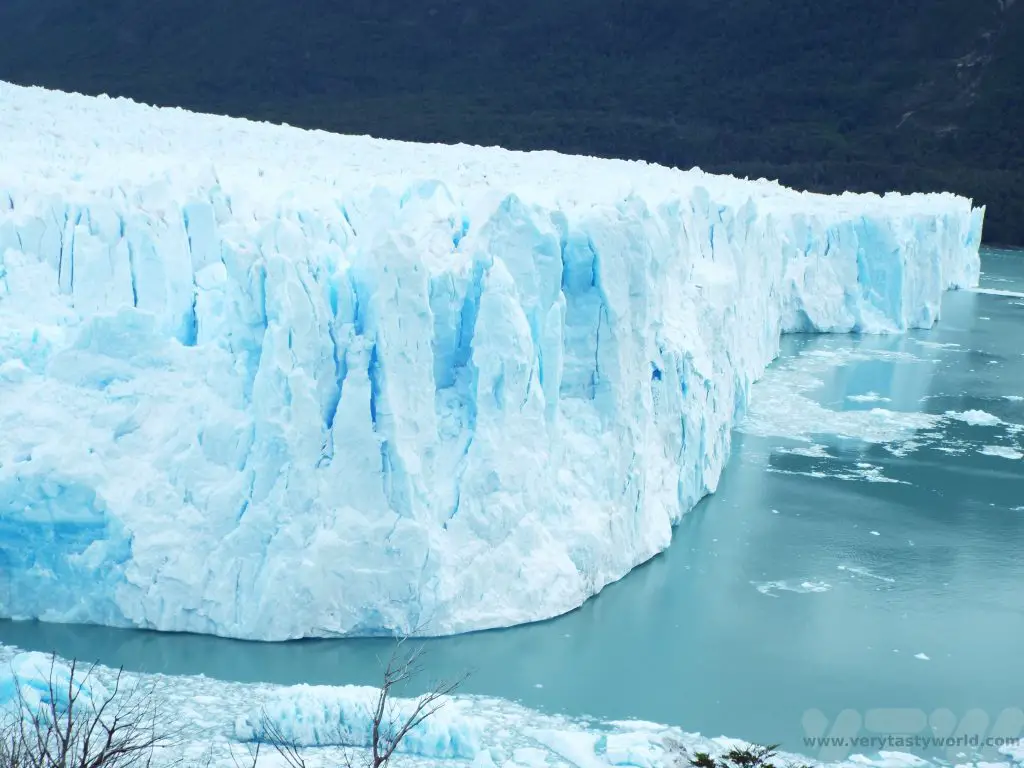

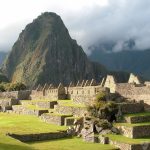
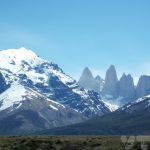
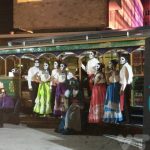







Really great post! A visit to an archipelago in the Pacific Ocean sounds like a real adventure. I don’t know if you have missed anything in this post, it’s very informative! Noce to see some of the fees being put in here so people can budget. Looks like you managed to see an abundance of wildlife on this journey which is great. Sometimes it’s better to have no wifi on a trip!
Thank you for your kind comment. We adored the Galapagos – and definitely recommend a visit. You’re right, sometimes no wifi can be a glorious thing!
The Galapagos have been on my list for a while, although I was lucky enough to go to the Ballestas islands in Peru (dubbed the “Poor Man’s Galapagos”) and was equally entranced by the boobies, penguins, and tortoises — such a magical experience.
I hadn’t realized that it was possible to do as much land-based travel in the Galapagos, which is an interesting option. Thanks for another intriguing post!
Lyn | http://www.ramblynjazz.com
Thank you! We’ve heard about the Ballestas but didn’t manage to see them when we visited Peru. It sounds as though you saw lots of wildlife. We were quite surprised but very pleased when researching the Galapagos how easy it was to do a land-based tour.
Some wonderful photos here of the wildlife that seems to be teeming everywhere. I didn’t realise that you could get so up-close to the wildlife – those iguanas look scary though and I doubt I’d want to get too close to them.
The other thing I didn’t realise is that the islands are volcanic. For some reason I just had visions of islands sprouting from the sea as rolling hills!
This sounds like a once in a lifetime trip ad you certainly made the most of it, despite the sea-sickness.
Really good advice here on the sequences of events while travelling the islands and what to expect.
Thank you. Yes it really was a special trip, despite the seasickness. The iguanas don’t look very friendly but are really benign – and you can’t help getting close to them. You have to be really careful to avoid stepping on them!
Ahhh the Galapagos are high on my list and we’ve been toying with how we want to see them. I didn’t realize that you could do it on land, so that’s really good to know and you got to see so many wonderful animals! Sharing with my family who really want to go as well!
Thank you! We hope you – and your family – manage to get to the Galapagos, they really are a special place to visit. We didn’t realise about the land based trips until we started researching. It was most definitely the best option for us. Thanks for sharing!
Never been to the Galapagos, but thanks to your post, I’m now thinking about visiting the Galapagos. Cheers for the info.
I looove the varied landscapes! The deep red sesuvium and the prickly pear cacti, the lava fields on Santiago, the twin volcanic craters at Los Gameles, it’s all so beautiful. Of course, I am so impressed with how many different animals you were able to see. Those blue-footed boobies are so cute haha. Good to know there are lots of regulations for protecting the animals.
Thank you! Yes, the diversity of landscapes and wildlife really make the Galapagos special. And we adored the blue-footed boobies!
What a wonderful trip! The images reflect well the beauty of the Galapagos and the biodiversity. I especially liked your care in clarifying the advantages and disadvantages of opting for the Land Based Tour.
Without a doubt it is a trip of a lifetime and for anyone who loves wildlife and being in communion with nature, it is a must!
Thank you. Yes, the Galapagos really fall into the category of trip of a lifetime, especially if you like wildlife and nature. Thank you for your kind comments about the post.
Galapagos is like a wild safari in the Pacific but wait there’s more! Guys I have a strong suspicious feeling that your Galapagos trip turned you to be little Charles Darwin or may have awaken those budding curiosities again. I’m jealous that you were able to see the creatures of my childhood dreams upclose. I’m already excited to be doing my own Galapagos escape one day. Loving the photos 😉 #flyingbaguette
Jan – https://flyingbaguette.com/
What a lovely description of the Galapagos as a Pacific safari! You’re right – we truly channeled our inner Darwins and really love the natural world. We do hope that you get to visit the Galapagos one day – they are truly marvellous.
The Galapagos Islands are a dream of mine and I soak up any personal blog posts that I can find about them. Your information is very insightful and helps me evaluating if the efforts would be worth it. I can imagine there was a lot of pre-planning involved. Organising a trip there without a cruise/tour operator must be super comprehensive. I’m intrigued and hope you don’t mind me asking, how long in advance did you book everything for your trip? Do you have to plan and organise everything down to the minute? I appreciate the cost breakdown as I can imagine the Galapagos Islands will make you pay for every little thing separately.
Carolin | Solo Travel Story
I do hope you get to visit the Galapagos, they are really wonderful. We did use a tour operator to organise the excursions – they were much better placed to be able to ensure availability and to confirm bookings on our behalf. It also meant that they could arrange the little details like the transfers to the boats for us. It was much cheaper than a cruise. We booked our trip around 6 months in advance as we were travelling at a less popular time of year – everything was available and we got so lucky seeing the birds during their mating seasons.
What a fabulous tour that looks and the wildlife photos are fantastic. Those seals sitting on the bench made me smile.
Thank you! The wildlife was truly marvellous. You could get so close to the creatures as they had no fear of humans. That’s also why the seal lions pinched the seat!
This is the itinerary for me! Visiting six islands is quite impressive. Galapagos cruises sound like a dream but they are so expensive… Do you think you saved money with your land based itinerary compared to a cruise?
Thank you! Yes, we definitely saved money by doing a land based trip. For us, it was the only way to travel – we got to see so much but minimised time on boats.
My husband gets seasick, too, so I am looking for a land-based itinerary. You saw so many animals on your trip with minimal boat time! This excites me to go to the Galapagos for the wildlife without getting annoyed at him for being sick half the time! I’ve also already narrowed down the time frame I want to go based on the breeding habits or juvenile animals I want to see. Great tip!
I really sympathise with your husband – seasickness is so horrid. The Santa Cruz – Isabela trip was the worst but it was around 2 hours’ duration. This was an itinerary that really worked for us because we spent such a short amount of time on boats and slept in hotels! Hope you get to visit, we are sure you will love these amazing islands.
I don’t usually get seasick but even this sounds like it might test me. Maybe as much as the chaotic luggage situation upon arrival at the airport. But what incredible wildlife to see once you get through all that. And so great that you can do so much without a lot of boat trips if you really don’t want to. It’s a place I’ve wanted to visit for a while and was even just talking about it, so maybe I’ll have to start planning a trip after all
If you don’t usually get seasick you should be okay. I (Mitch) am totally rubbish on boats – most people were okay! It was absolutely worth the nausea when we saw the wildlife – it really is nothing short of spectacular. Visiting the Galapagos was a dream fulfilled. Hope you get to visit, we are sure you would love it!